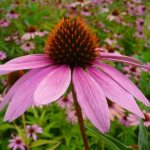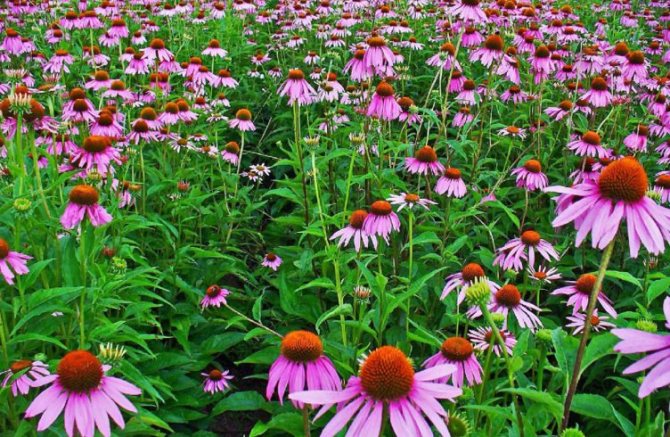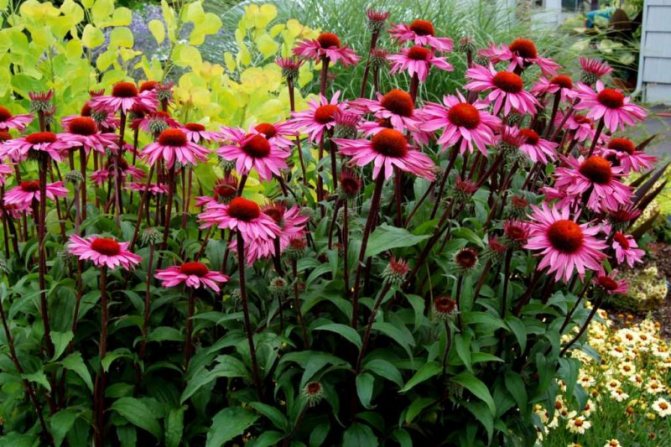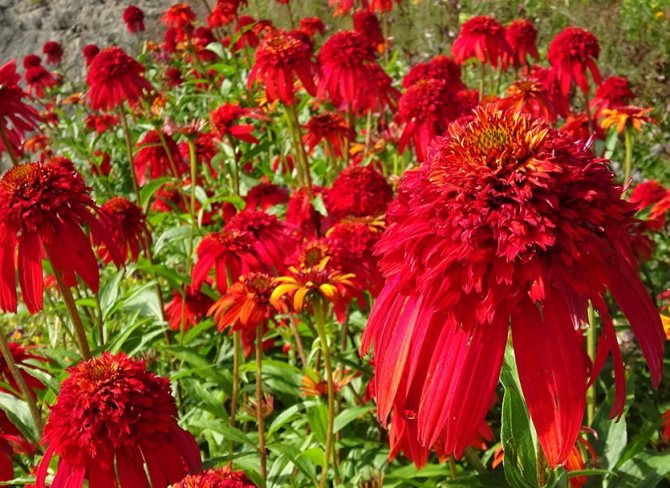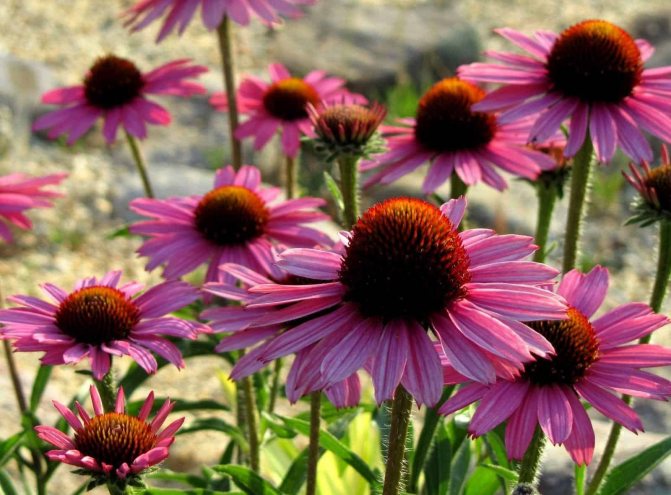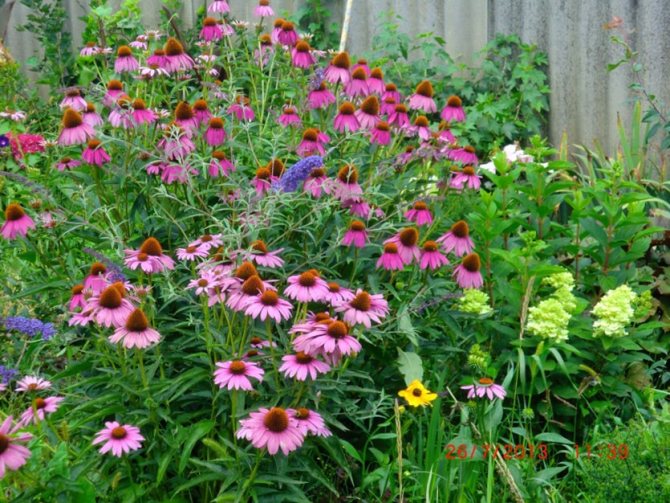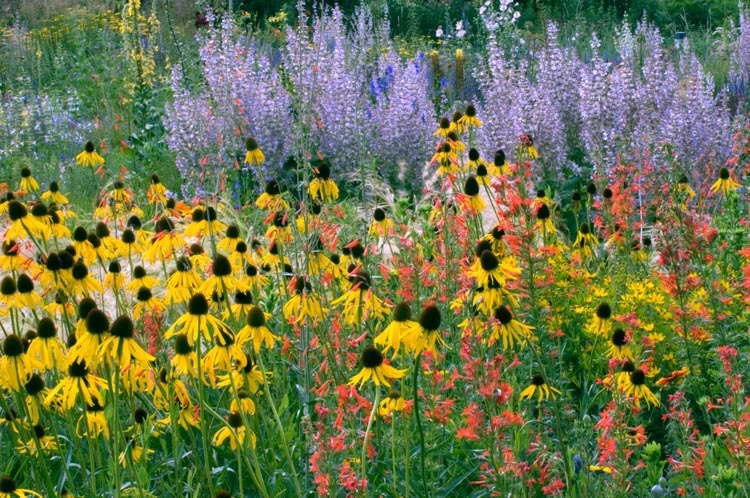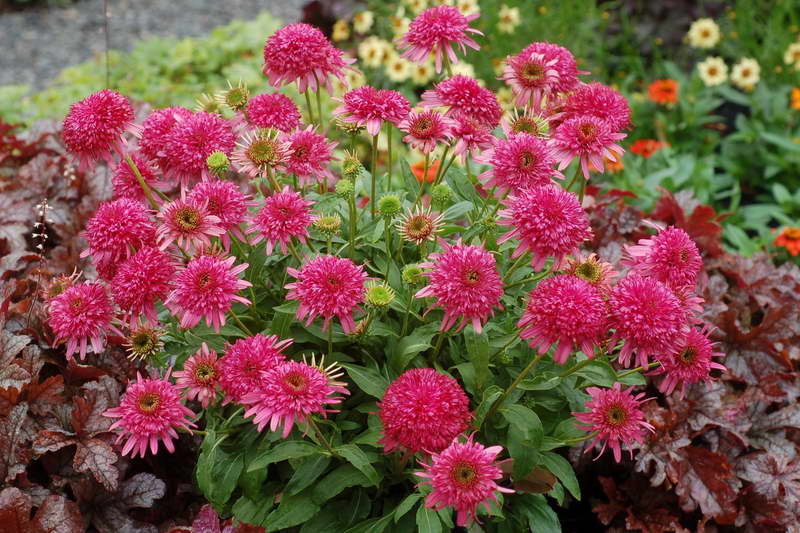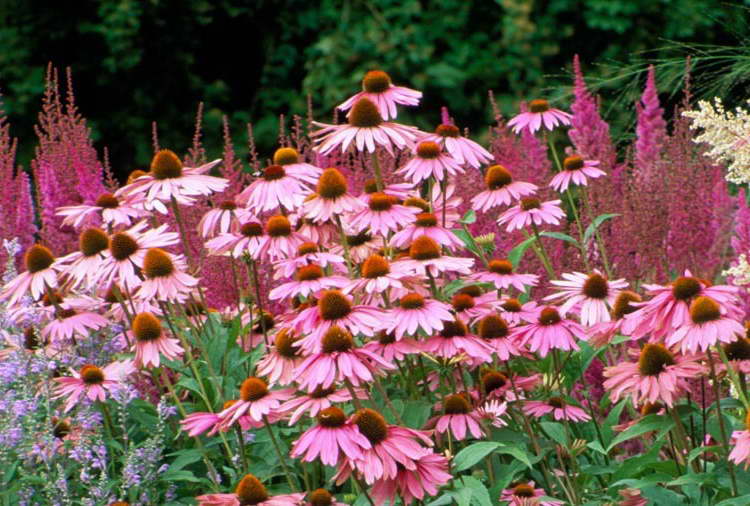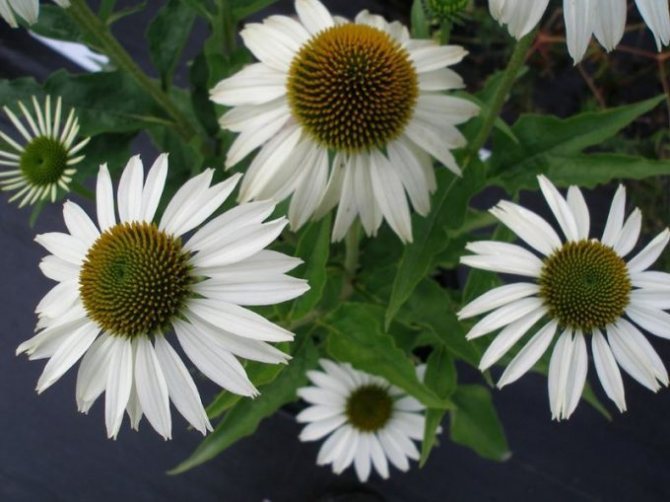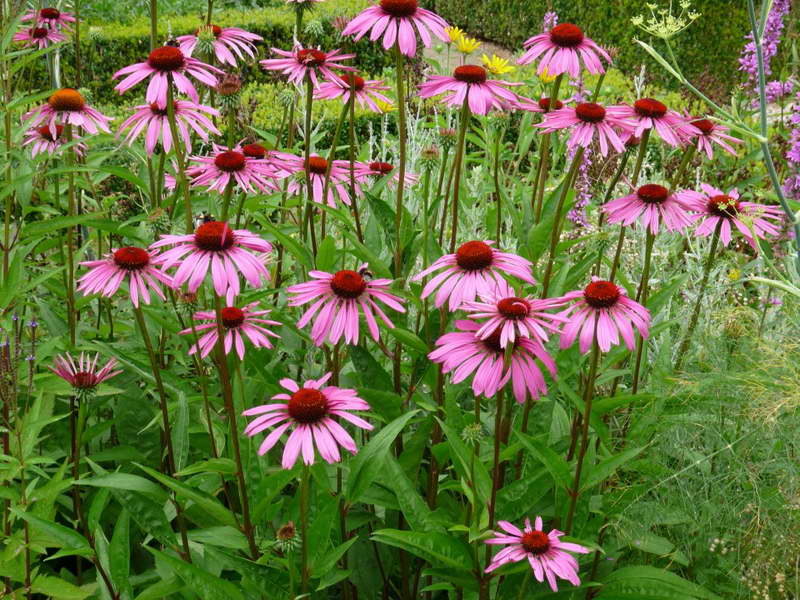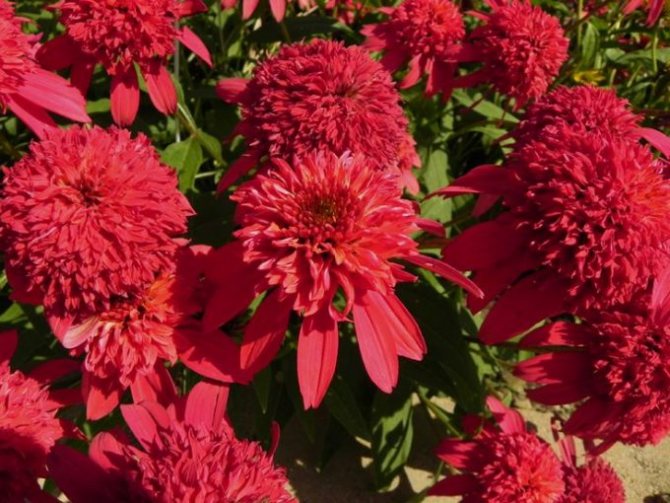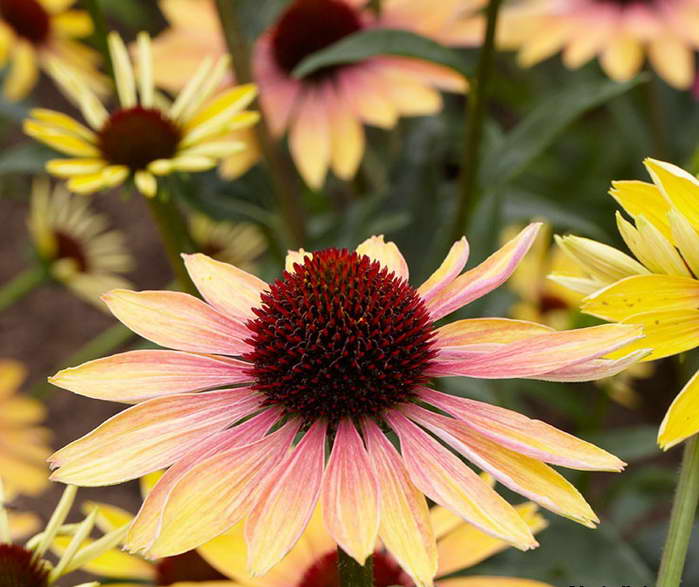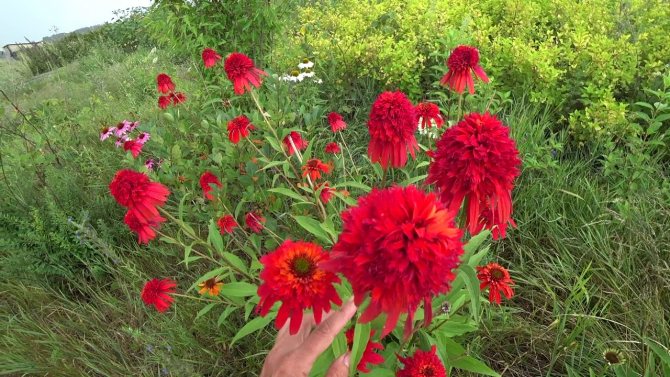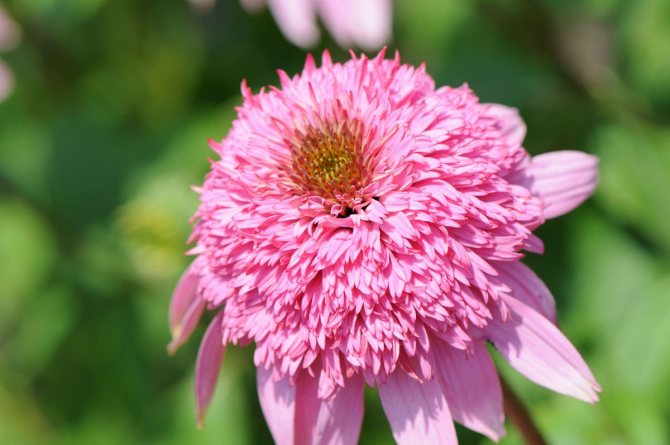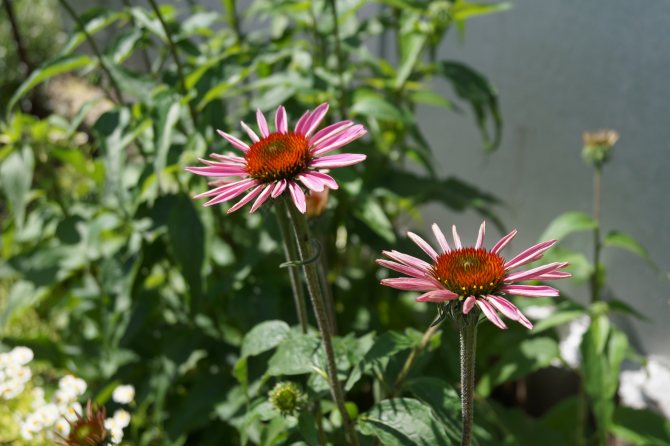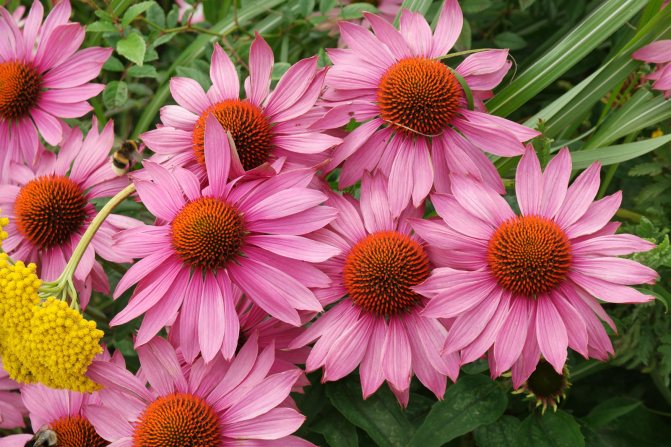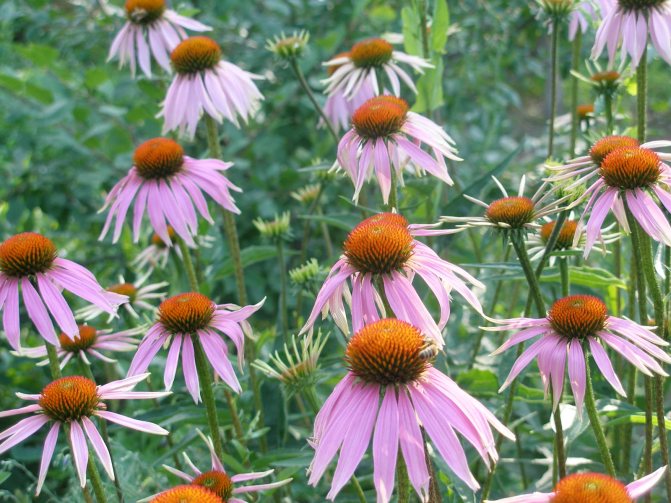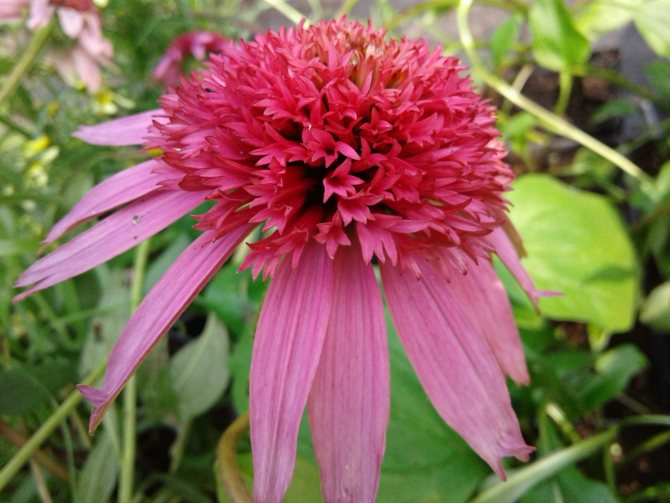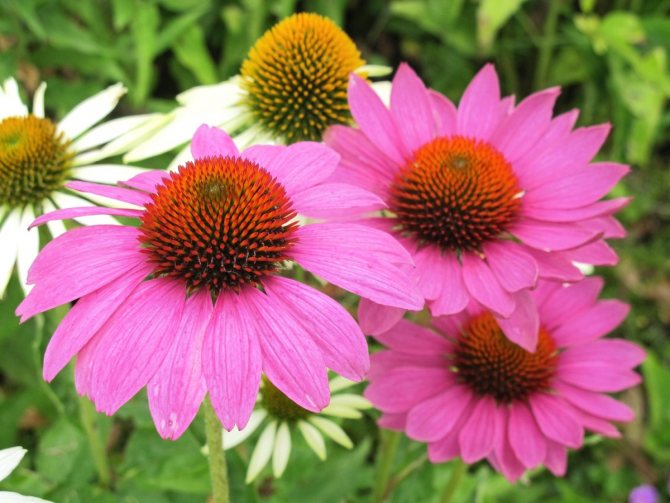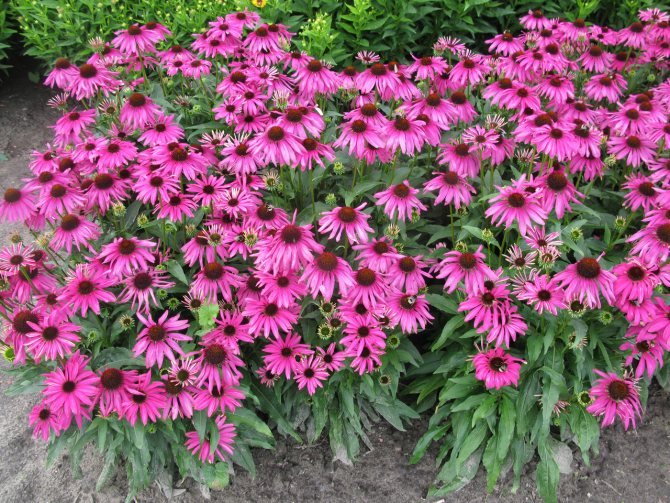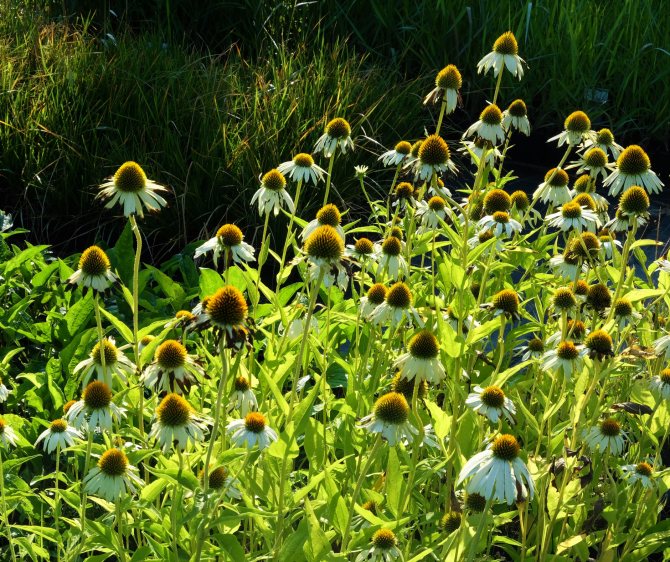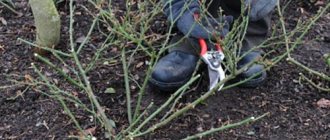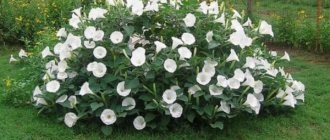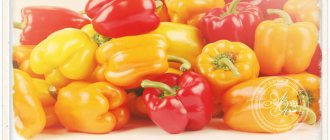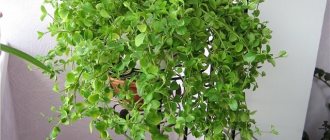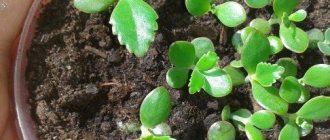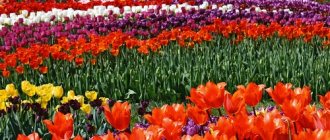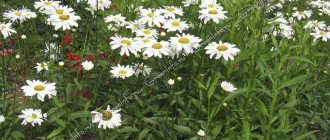The large purple, pink or white chamomile inflorescences of these plants look delightful in late summer in mixborders and herbaceous borders. Inflorescences-baskets up to 15 cm in diameter consist of petal-shaped marginal flowers, radially diverging from a conical receptacle, bearing small tubular flowers. Each inflorescence is formed on a high stem, also bearing alternate lanceolate green leaves up to 20 cm long. New flowers can continue to bloom for more than two months and do well when cut. They are often used in dry bouquets. Homeland - the east of the United States. These rhizome perennial herbaceous plants are quite winter-hardy.
Echinacea
Description of the plant
Echinacea is a perennial plant of the Asteraceae family. Today, about 10 varieties are known, most of which are cultivated. The homeland of this unusual flower is North America, but it is also found in many European countries. The name of the plant is translated from Greek as "prickly like a hedgehog". For the first time, echinacea was described by Karl Linnaeus, mistakenly identifying it as a genus of rudbeckia. The inaccuracy in the classification was corrected only at the beginning of the 19th century.
Externally, Echinacea is a perennial herb with a tall, erect stem. It reaches a height of up to 1.5 m, has a very rough structure, which is the reason for the name. The leaves are oval with jagged edges and are attached to the stem with long roots.
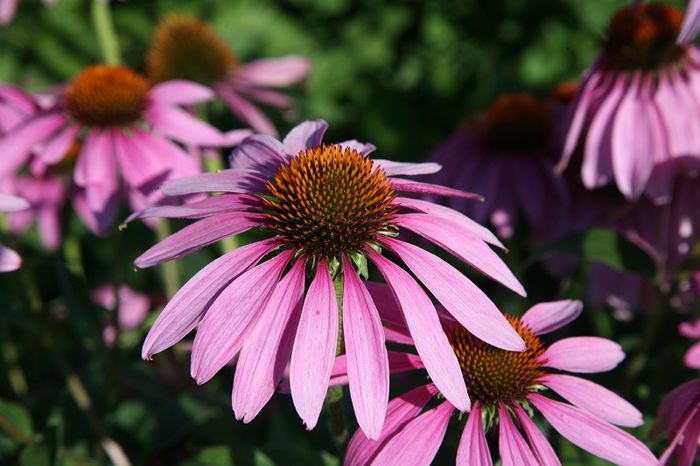
Flowering is long, can begin in mid-July and end only in August. The inflorescence is a large basket, collected and reed flowers. The color of the petals can be different depending on the variety; it is valued for its color saturation. After flowering, an achene is formed, which can be collected and used for planting for the next season. Echinacea is also known as a medicinal plant; almost all vegetative parts have healing properties. In landscape design, it is used for group and single plantings. Combines with other members of the Aster family, peonies and coniferous shrubs.
Echinacea in landscape design
Calendula (marigold) is a flower that stands out among others for its bright color. Low bushes with delicate orange blossoms can be found on the side of the road, in the meadow, in the front garden next to the house, or even in the vegetable beds. Calendula is so widespread in our area that it seems that it has always grown here. Read about interesting decorative varieties of calendula, as well as the use of calendula in cooking and medicine, in our article.
I think many will agree that we perceive the wind well only in a romantic aspect: we are sitting in a cozy warm house, and the wind is raging outside the window ... In fact, the wind blowing in our areas is a problem and there is nothing good in it. By creating windbreaks with plants, we break the strong wind into several weak streams and significantly weaken its destructive force. How to protect the site from the wind will be discussed in this article.
Modern ferns are those rare plants of antiquity, which, despite the past time and all kinds of cataclysms, not only survived, but in many respects were able to retain their former appearance. In the indoor format, of course, it is not possible to grow any of the ferns, but some species have successfully adapted to life indoors. They look great as single plants or adorn a group of decorative deciduous flowers.
Pilaf with pumpkin and meat is an Azerbaijani pilaf, which differs from the traditional oriental pilaf in the way of cooking. All ingredients for this recipe are prepared separately. Rice is boiled with ghee, saffron and turmeric. The meat is fried separately until golden brown, pumpkin slices as well. Onions and carrots are prepared separately. Then everything is laid in layers in a cauldron or a thick-walled pan, pour in a little water or broth and simmer over low heat for about half an hour.
Basil is a wonderful universal seasoning for meat, fish, soups and fresh salads - well known to all lovers of Caucasian and Italian cuisine. However, upon closer inspection, basil greens are surprisingly versatile. For several seasons, our family has been drinking aromatic basil tea with pleasure. In a flower bed with perennials and in flowerpots with annual flowers, a bright spicy plant also found a worthy place.
Thuja or juniper - which is better? This question can sometimes be heard in garden centers and in the market where these plants are sold. It is, of course, not entirely correct and correct. Well, it doesn't matter what to ask, which is better - night or day? Coffee or tea? Woman or man? Surely, everyone will have their own answer and their own opinion. And yet ... But what if you approach without prejudice and try to compare the juniper and the thuja according to certain objective parameters? Let's try.
Ginger cream cauliflower soup with crispy smoked bacon is a delicious, tender and creamy soup that will appeal to both adults and children. If you are preparing a meal for the whole family, including toddlers, then do not add a lot of spices, although many modern children do not mind spicy flavors at all. Bacon for serving can be cooked in different ways - fry in a pan, as in this recipe, or bake in the oven on parchment for about 20 minutes at 180 degrees.
For some, the time of sowing seeds for seedlings is a long-awaited and pleasant chore, for someone it is a heavy need, and someone is thinking about whether it is easier to buy ready-made seedlings on the market or from friends? Be that as it may, even if you have given up growing vegetables, for sure, you will still have to sow something. These are flowers, perennials, conifers and much more. Seedlings remain seedlings, no matter what you sow.
A lover of humid air and one of the most compact and rare orchids, paphinia is a real star for most orchid growers. Its bloom rarely lasts longer than a week, but it can be an unforgettable sight. Unusual striped patterns on huge flowers of a modest orchid want to be considered endlessly. In room culture, paphinia is rightly included in the ranks of species that are difficult to grow. It only became fashionable with the proliferation of indoor terrariums.
Pumpkin and ginger marmalade is a warming sweet that can be made almost all year round. Pumpkin has a long shelf life - sometimes I manage to save a few vegetables until summer, fresh ginger and lemons are always available these days. Lemon can be substituted with lime or orange for different flavors - variety in sweets is always a pleasure. Ready marmalade is laid out in dry jars, it can be stored at room temperature, but it is always healthier to cook fresh food.
In 2014, the Japanese introduced petunia with an amazing color of petals - salmon-orange.By associations with the bright colors of the southern sunset sky, the unique hybrid was named African Sunset. Needless to say, this petunia instantly won the hearts of gardeners and was in great demand. But in the past two years, the curiosity has suddenly disappeared from the shop windows. Where has the orange petunia gone?
Our family loves sweet peppers, so we plant them every year. Most of the varieties that I grow have been tested by me for more than one season, I cultivate them constantly. And every year I try to try something new. Pepper is a thermophilic plant and quite whimsical. The varietal and hybrid varieties of tasty and fruitful sweet pepper, which grows well with me, will be discussed further. I live in central Russia.
Meat cutlets with broccoli in béchamel sauce are a great idea for a quick lunch or dinner. Start by cooking the minced meat, and at the same time heat 2 liters of water to a boil to blanch the broccoli. By the time the cutlets are fried, the cabbage will be ready. It remains to collect the products in a pan, season with sauce and bring to readiness. Broccoli must be cooked quickly in order to maintain a bright green color, which, if cooked for a long time, either fades or the cabbage turns brown.
Home floriculture is not only an exciting process, but also a very troublesome hobby. And, as a rule, the more experience a grower has, the healthier his plants look. And what about those who have no experience, but want to have houseplants at home - not elongated stunted specimens, but beautiful and healthy, not causing a feeling of guilt by their extinction? For beginners and florists who are not burdened with a lot of experience, I will tell you about the main mistakes that are easy to avoid.
Lush pancakes in a frying pan with banana-apple confiture is another recipe for everyone's favorite dish. So that the cheesecakes do not fall off after cooking, remember a few simple rules. Firstly, only fresh and dry cottage cheese, secondly, no baking powder and soda, and thirdly, the thickness of the dough - you can mold it from it, it is not tight, but pliable. A good dough with a small amount of flour will only come from good cottage cheese, but here again see the point "first".
Echinacea
a flower that surprisingly combines exquisite beauty and unique healing properties. This plant has long and firmly established itself in our flower beds and flower beds.
A little about the plant
Echinacea is native to South America. It has been known there since time immemorial. The Indians, the indigenous inhabitants of those places, gave it a romantic name - "Evening sun
". Pretty accurate name. Especially in relation to the most common species in our country - "
Echinacea purpurea
". Sometimes there is another name for it - “
Rudbeckia purpurea
". It is believed that Karl Linnaeus himself named it so, who described it and placed it in the Rudbecky genus. But over time, this decision was revised, and echinacea was allocated to a completely separate genus of the "Astrovye" family. Unlike the Indian name, the translation of the name of this plant from Greek into our native language is less romantic. Echinacea (
Echinacea
) - prickly. This is a rather tall flower, often reaching a height of 1.5 meters. It blooms profusely and for a long time with beautiful large flowers, leaving behind a considerable amount of seeds in the achene fruit. It is this fruit that bristles with seeds - thorns, which gave the name to the flower. In addition to Echinacea purpurea, other varieties have been bred that are different in color: pink-orange (Cantaloupe variety), yellow (Cleopatra variety), dark red (Sonnelach variety), orange (Julia variety), golden (Passion Flut variety).
Types, varieties
There are 10 known plant varieties, but only Echinacea purpurea and hybrids derived from it are most often used as a cultivated and medicinal plant.It is a perennial plant, reaching a height of 1.2 m. It has an erect, rough stem, on which broad-oval leaves are located.
The petals grow up to 4 cm in length, have a tubular shape with a slight taper at the top. Traditionally, the flowers are colored reddish-brown, but a large number of varieties have been bred with a very different color of the buds. Popular varieties:
- Art's Pride. Plant height - 75 cm. It has narrow, lowered petals of a red-orange hue (see photo), is unpretentious and highly resistant to adverse conditions;


- Green wizard... Medium-sized variety of American selection. The stem grows up to 50 cm. The petals are bright pink, in the center there is a golden spot;
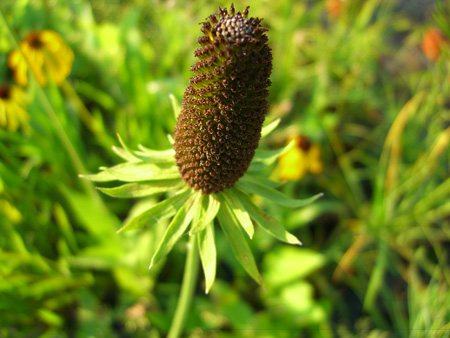

- Kim’s Knee High... A compact plant, reaching a height of 45 cm. At the beginning of flowering, the petals are pink, then darken to a crimson color;
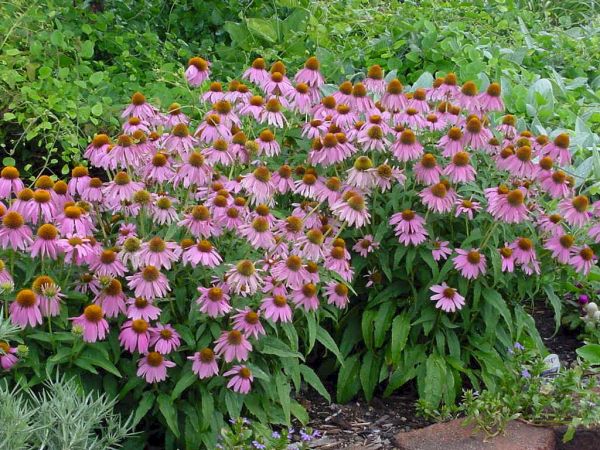

- Magnus. Grows up to 90 cm in height. The flowers are pink-crimson, the central part has a brownish bulge;
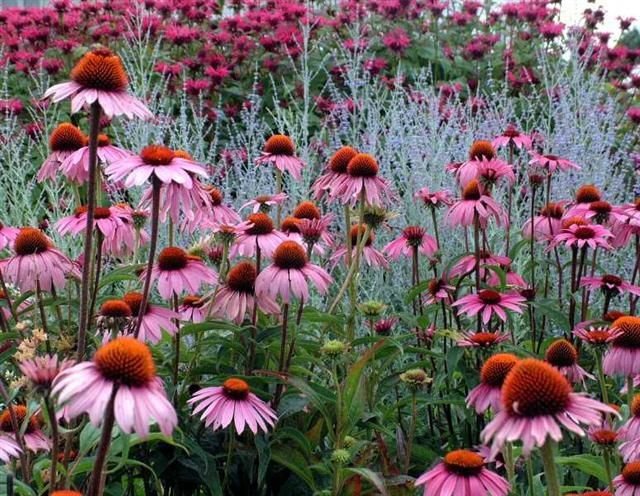

- Little giant... Dwarf variety, height - 35-40 cm. The petals are very elastic, painted in a bright purple color;
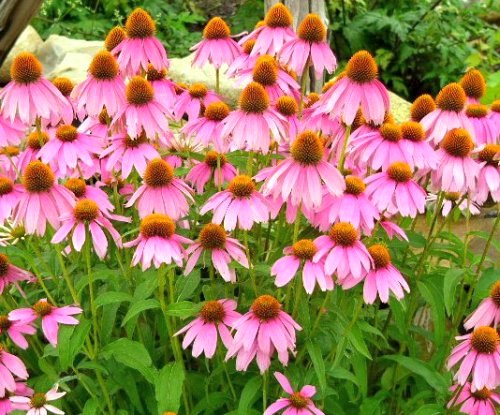

- Mars... Reaches a height of 80 cm. The marginal petals are deep red. The bush is quite powerful and strong, it can withstand the effects of even strong winds.
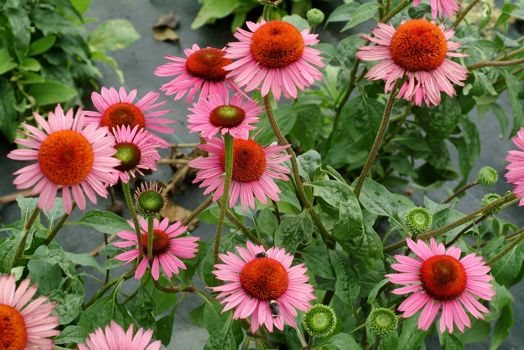

Among domestic gardeners, the hybrid Sunset series is very popular, bred by crossing Echinacea purpurea and paradoxical. The plant is distinguished by its large bud size, decorative curved petals and a pleasant aroma during flowering. Interesting varieties in this group are Julia, Cantaloupe, Cleopatra, Evening Glow and Double Scoop Cranberry.
Description of echinacea
Echinacea is the world's most popular medicinal plant. It has a creeping, rooting rhizome, straight trunks about 2 m tall and small inflorescences-baskets. The foliage is extensive, almond-shaped with a toothed rim. Petals are purple, yellow, scarlet. The central half of the inflorescence has a pure burgundy color with a brownish tone. The flowering period is from mid-July to September. It is perfect for decorating gardens, parks and forest corners. Many flower fans prefer her.
But, admiring the beautiful flowers, people do not realize that this wonderful plant is a healer of many ailments, strengthens the immune system.
Choice of place and conditions of detention
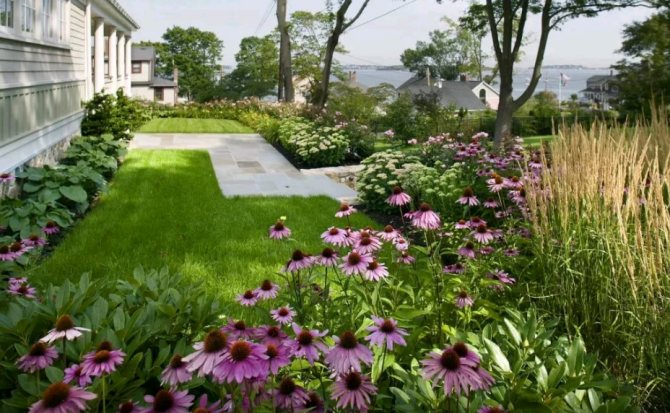

Despite the fact that echinacea is a rather unpretentious plant, the competent choice of a place for planting directly affects the health of the flower, the growth rate and the quality of flowering. This is a perennial that can grow in one place for more than 5 years, so the choice of a flower garden should be approached responsibly.
Lighting and location
Echinacea is a light-loving plant, it is advisable to choose a place for planting in the southern part of the site and well-lit part of the site. Even partial shade can lead to a decrease in the saturation of the color of the petals, a slowdown in the growth of the bush. The flower looks good both in multi-species flower beds, rockeries and mixborders, as a single plant.
Experienced growers recommend planting several varieties next to each other, which will improve the appearance of the planting. Do not plant a flower near a fence or building, or under the shade of tall trees. It is also possible to grow it as a pot culture.
Temperature
An adult plant is quite unpretentious in terms of temperature. It can grow and bloom in a wide temperature range from 14 to 28 ° C. Young bushes are especially susceptible to drops, therefore, seedlings, even when planted directly in open ground, need to be covered. During the first two years of life, echinacea has weak immunity and winter hardiness, so preparation for winter is a must.
Air and humidity
Moderate humidity is required for the comfortable development and health of the plant.It is not recommended to plant echinacea next to a body of water, on excessively moist soils. This increases the risk of developing fungal infections, leading to yellowing of the leaf blades. During the season, it is required to monitor the condition of the soil, to avoid waterlogging and drying out.
Drafts and strong winds can be detrimental to young echinacea during the first two years of life. When planting in open areas, it is recommended to put a support, and in regions where there is a risk of strong winds, you need to put a support, especially when growing tall varieties.
Priming
For the cultivation of echinacea, a nutritious and fertile soil with a slightly alkaline or neutral acidity level is recommended. The land must be well aerated, therefore, even in the process of preparing the flower beds for this purpose, it is recommended to add peat or river sand. Planting is undesirable in areas with too light and sandy soil, as well as in places with high humidity, for example, clay soils.
Planting care
Echinacea does not require special care, but plantings cannot be left unattended either, otherwise they will lose their decorative appearance and may die.
- planting should be watered sparingly, but regularly, preferably in the evening. Plants tolerate a short-term drought normally, but in the absence of watering for a long time, they will dry out. Excessive watering is also harmful to echinacea - with stagnant moisture, the petals will be too pale and quickly fall off;
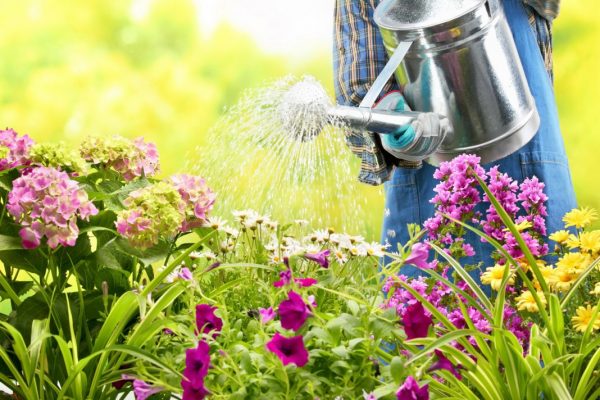

The main thing in plant care is proper watering.
- in the area where the crop grows, you need to regularly remove weeds and loosen the soil after each watering in order to improve its air permeability;
- you need to feed the plants twice a season, starting from the second year of life. In the spring, mixtures with a nitrogen content are introduced into the soil, and during the period when the first buds appear, potassium and phosphorus are added. Mineral fertilizers can be replaced with rotted compost mixed with wood ash;
- to stimulate flowering, dried inflorescences must be cut to the first leaf. If you need to collect seeds for subsequent sowing, you should leave several of the largest flowers on the bush;
- to collect the seeds, you need to wait until the petals fall off, and the middle darkens slightly, then carefully collect the seeds, clean them of dust and dry them. Since the seed does not differ in good germination, it is better to plant it as soon as possible;
- once every 3-4 years, it is recommended to rejuvenate echinacea by dividing the bush - dig up the plant, divide the root so that there are several buds on each part, and plant them;
- before the first frosts in the bushes, the entire above-ground part should be cut off, the remaining part should be mulched with a thick layer of compost, and covered with spruce branches or dry foliage on top.
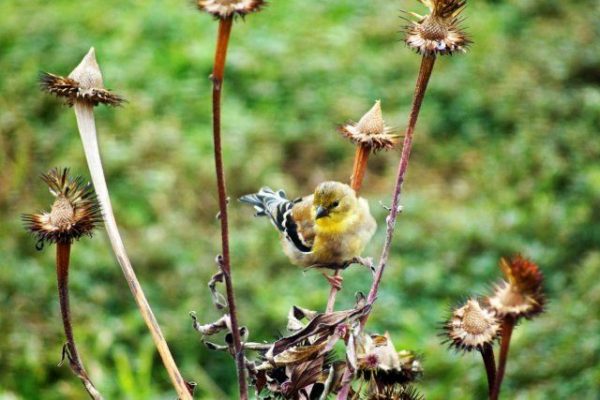

It is better to remove seed boxes to avoid self-seeding.
Important! If echinacea is planned to be used for therapeutic purposes, it is better to refuse mineral dressings, otherwise harmful substances will accumulate in the leaves and flowers.
Wood ash prices
wood ash
Video - Cultivation of Echinacea
When to plant echinacea
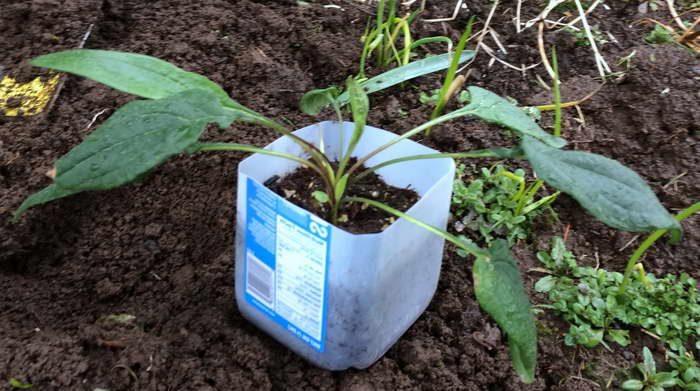

Echinacea can be planted in spring or fall. Usually, the process is combined with the division of the bush, since the seed propagation method is used only for species varieties.
In the spring, echinacea is planted after the end of winter frosts, when the air warms up by at least 10-12 ° C, when dividing the bush, the formation of the first growth buds should not be allowed. In the southern regions, the optimal time is the end of April; in the north of the country, it is recommended to wait until mid-May, when the threat of temperature drops at night will recede.
In autumn, echinacea is planted only by dividing the bush or by seed method in the presence of a year-round heated greenhouse. As a rule, this is the second half of September - the first decade of October. In the south of Russia, a transplant or division of a bush can be postponed until the end of October.
Landing in an open place
Since echinacea seedlings are very delicate, it is better to plant them in an open place at the end of May, when the threat of a significant drop in temperatures is over. In the selected area, you should dig holes with a diameter slightly larger than an earthen coma, the distance between them is at least 30-40 cm, depending on the variety. At the bottom of each of them, put a handful of compost mixed with a pinch of wood ash, transfer the seedlings there, trying not to shake the earth from the roots and not damage them. After that, cover the young plants with earth and water abundantly.
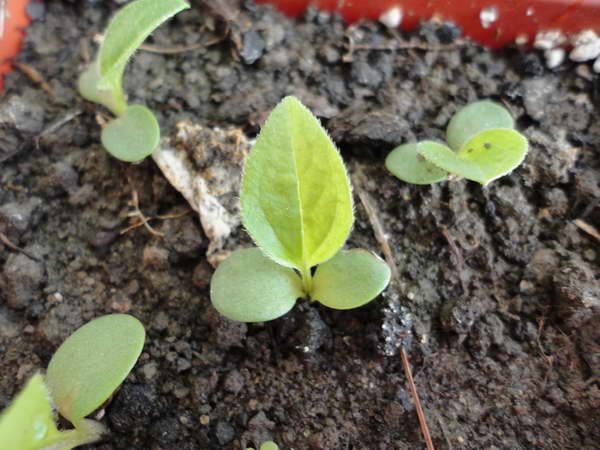

Echinacea seedlings are transferred to the garden plot after the onset of stable heat
Landing preparation
Before planting, you need to carefully dig up the area, remove the remnants of plants, stones and other elements. As a fertilizer, mullein, bird droppings or humus are applied at the rate of up to 5 kg per meter. In infertile soils, it is recommended to add granular mineral complex fertilizing in accordance with the dosage on the package.
For planting seedlings, individual pits are prepared with a depth of 5 cm and a distance of 30 cm from each other. If you use a bush division, but the depth of the hole should be 2-5 cm more than the rhizome (on average, 20 cm). All procedures must be carried out no later than 1.5 months before planting.
Planting echinacea outdoors
Seed-grown plants are planted in spring, while split bushes can be planted in both spring and fall.
Choose a well-lit area with fertile soil for planting. Echinacea does not like acidic earth. If necessary, deoxidize it. It is ideal to put into the ground, but you can also carry out the usual. Also, avoid planting in sandy soil and in places with stagnant water that are too wet.
For planting echinacea seedlings, make small holes 5 centimeters deep. But basically, this depth will depend on the size of your seedlings, its root system. Keep the distance between seedlings in a group planting 30 centimeters. Roughly the same pattern is maintained for planting a part of the echinacea bush. Only make the planting hole slightly larger than the size of the plant's root system. It is advisable to pour a small amount on the bottom of the pits. In this case, make the size of the landing hole for echinacea taking into account such an additive.
Planting process
The algorithm for planting a split bush or seedlings is practically the same, the only difference is in the size of the planting moon, the rest of the technology is identical. Step by step process:
- At the bottom of a pre-prepared hole (about a third of the volume), you need to pour a mixture of sand and compost in equal proportions.
- Carefully place the young plant in the hole, and then sprinkle with fertile soil, lightly tamp the top layer. It is best to transfer seedlings from containers together with a clod of earth.
- The planting should be watered abundantly with water; if there is a threat of night frosts, cover with spruce branches, agrofibre or straw.
It is recommended to mulch the flower bed immediately. This reduces the rate of growth of weeds, the layer of mulch will retain moisture and heat on the soil surface.
The many-sided beauty of echinacea - decoration of your flower garden
Echinacea is attractive for its exquisite bright flowers. But it is valued mainly not for its appearance, but for its healing properties. Having grown this flower on your site, you will admire its beauty. Moreover, it is quite easy to grow it.
Echinacea is considered to be an easy-to-grow plant that strikes the eye with its many bright, decorative, varied in color and very large flowers, resembling chamomile in appearance.


It is interesting that by planting this flower on your site, you thereby invite bees and a lot of butterflies, which will add even more color to your site. Although echinacea itself is striking in the variety of flower colors.It can be pink flowers, as well as crimson, yellow, orange. There are also salmon-colored flowers.
Content
How is echinacea planting


Having invited echinacea to your site, be prepared for the fact that in the first year of life it forms only a rosette with leaves, but its flowering will be in the second year. She will begin to bloom in mid-July, and will delight the eye with her bright outfit until mid-September.


Caring for your plant won't be difficult if you create the right growth conditions for it from the start.
Follow these guidelines, and you can grow echinacea in your area:
- Echinacea should only be planted in the sun. A thermophilic plant will not survive in shade or partial shade.
- The composition of the soil can be anything. However, the plant will grow and develop for a long time (although, nevertheless, flowering will come) if the soil is sandy.
- For planting, you need to prepare small holes up to 5 cm deep, the distance from one hole to another should be about 30 cm. A layer of compost should be placed on the bottom, then echinacea should be planted.
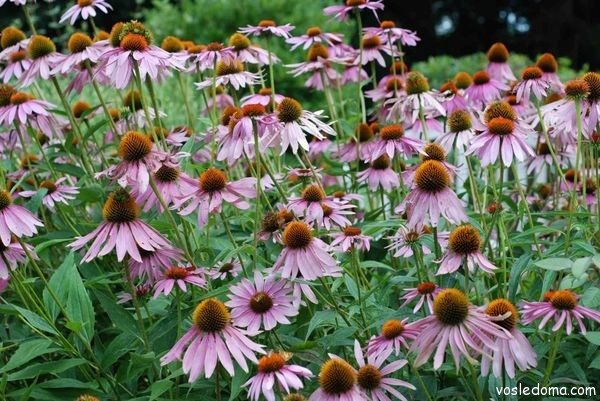

If you bought an adult echinacea, because you did not want to wait for the plant to bloom for more than a year, then you will have fewer problems with planting. You can plant the plant throughout the season. You just need to dig a hole - about 40 cm, fill it with a mixture of sand, garden soil and compost in equal parts. Echinacea, together with the soil from the pot, is planted in a hole at the same depth at which it grew in the planting container.
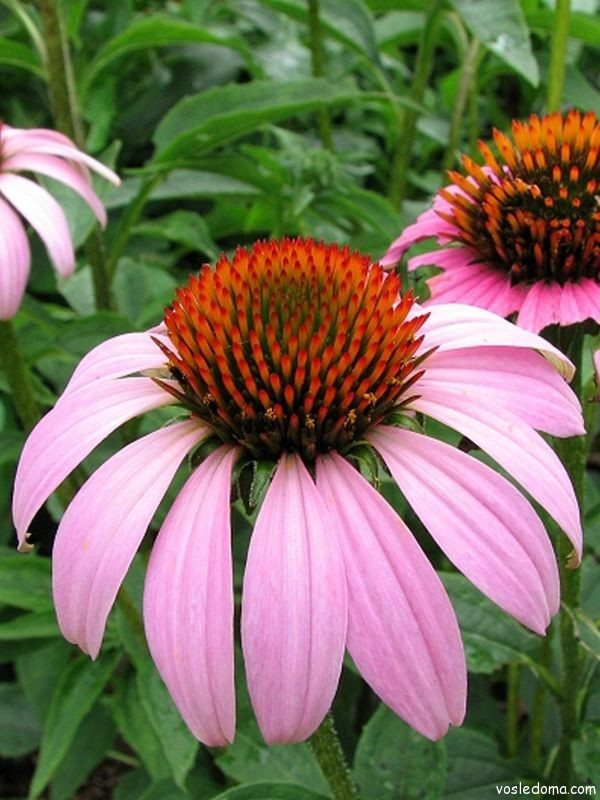

How to propagate echinacea
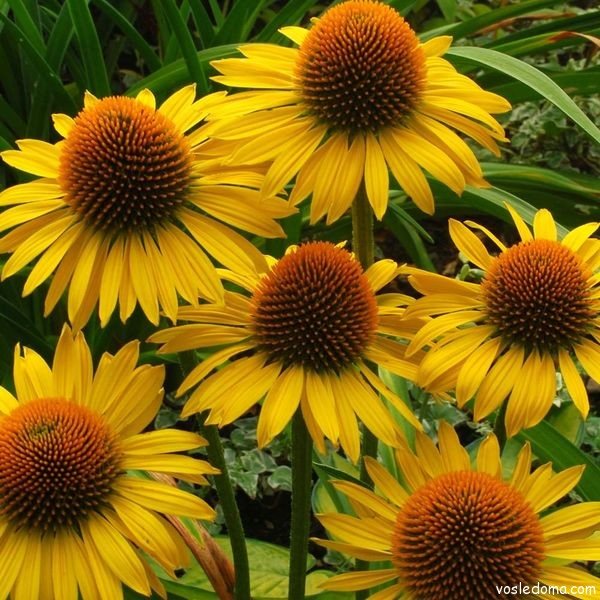

Seeds
Echinacea is best propagated by seed. They are sown in open ground or in previously prepared containers. You need to sow seeds at the end of February, and it is better if you do this in a container. From above, it should be tied with a millimeter layer of ordinary sand and carefully moisten it from a spray bottle. The optimum temperature for growing is +13 ° C.
Do not worry if you do not see the first shoots as soon as you would like. The seeds will germinate only a month and a half after sowing. It is at this moment, when the sprout of the plant is very small, it needs special care. Tiny echinacea seedlings should be provided with optimal moisture and warmth, so it is better to germinate them first at home, and only then plant them in open ground (this should be done in early May). After planting the plant in open ground, you do not need to worry too much about caring for it. Just water the soil near it evenly and loosen it occasionally.
By dividing the bush
Echinacea should be propagated in this way in early April. To do this, immerse the cuttings for a couple of hours in a solution of a liquid immunostimulant and plant, trying not to deepen the root necks of the cuttings too deep. Root collars should not be below the soil level.


What kind of care does Echinacea need?


This plant does not need any special care. But some activities, the most elementary ones, for caring for a plant, nevertheless, will have to be carried out.
- The plant loves moisture. The soil should be watered abundantly in the evening.
- Mineral and organic fertilizers should be applied annually.
- Top dressing is recommended to be applied twice: in the spring after planting and during the budding period.
- At the end of October, all Echinacea stems should be cut off. The root collar must be covered with compost and then covered with a layer of dry leaves.
Echinacea diseases
The plant is almost not susceptible to disease. However, during the rainy season, rot and powdery mildew can appear on Echinacea. A fungicide treatment will be required and the echinacea will be saved.
Types and varieties of echinacea
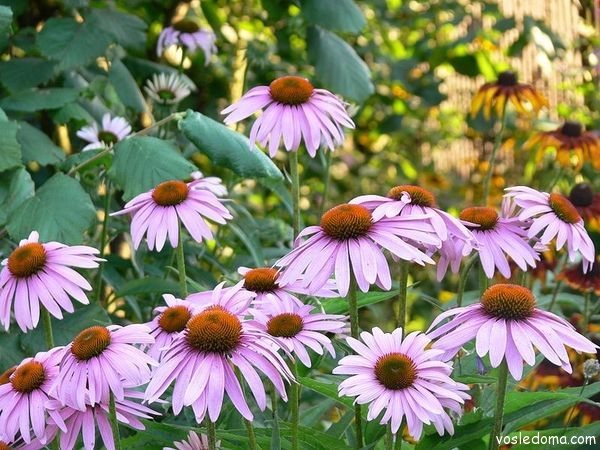

There are 9 known species, each of which is good in its own way. In our time, the most popular are the following types: Echinacea Strange and Echinacea Purpurea. Let's consider them in more detail.
Echinacea Strange (Echinacea paradoxa Britton)


It is the only plant of its kind that boasts a bright yellow outfit that is especially attractive in the summer sun.
Echinacea purpurea (Echinacea purpurea)
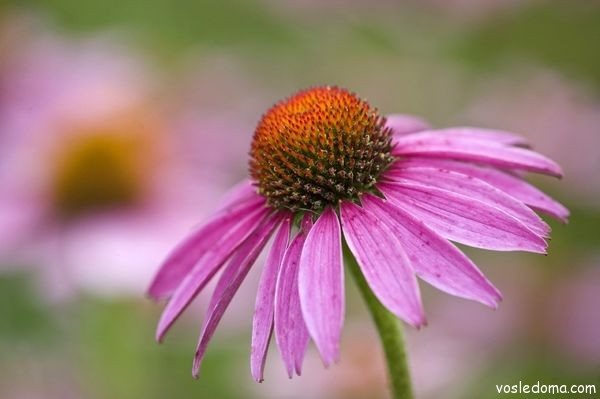

This species has flowers reaching 12 cm in diameter; in the center, a brown core is visible, which resembles a dome. Echinacea purpurea in the wild grows on rocky hills, fields, forests. If you want bright spots of echinacea to decorate your site and fill them with coolness, a variety of shades throughout the notch, then be sure to grow it at home.
Echinacea purpurea has different varieties. Here are the most popular ones:
Echinacea cultivar Cranberry Cupcake - a representative of beautiful terry varieties. It has flowers of a deep pink hue.


Echinacea varieties The King - a tall plant. Reminds of field daisies. Although the flowers have a reddish-pink hue, their diameter is up to 15 cm.
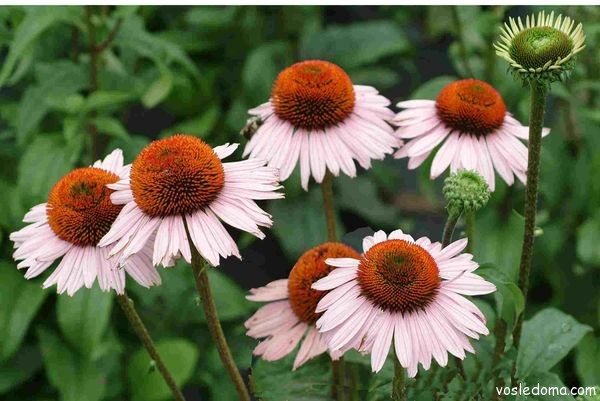

Echinacea varieties White Swan - and this variety, translated as "white swan", is very similar to its predecessor, has a white tint of flowers. Flowers are almost an exact copy of daisies; this variety of echinacea differs from them only in the core and height of the stem.
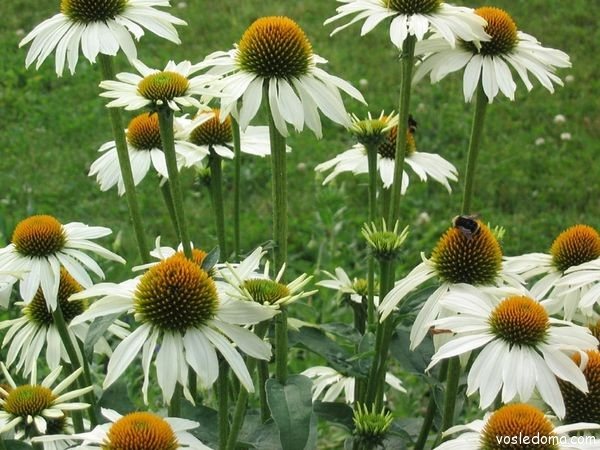

Echinacea varieties Indiaca - another tall plant of the Echinacea purpurea species, reaching a height of 75 cm. Flowering begins in June and ends at the end of summer. Its interestingly shaped ligulate flowers have a variety of colors - from pink to orange-brown.


Echinacea varieties Magnus has a stem of 90 cm. Flowering begins in early July and lasts until mid-autumn. The plant will delight with flowers of a pink-crimson shade and a heart of a bright orange (sometimes brown) shade.


By planting any type of echinacea in your garden, you will attract butterflies to the site.
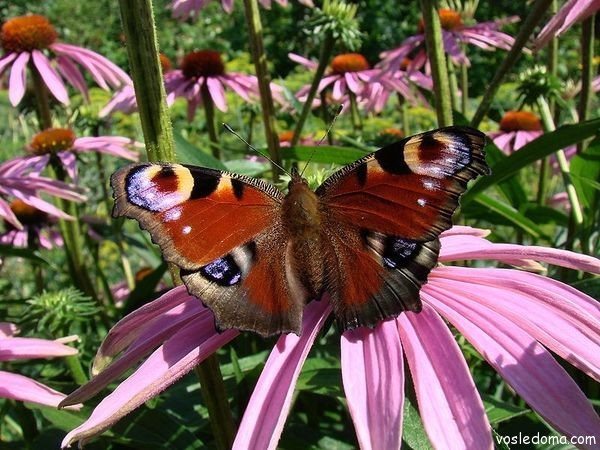

These creatures evoke a feeling of admiration, since, observing them, it seems that they have no worries. Therefore, forget about worldly concerns in your garden, planting echinacea on it and luring these fluttering creatures of incredible color to the site.
The many-sided beauty of Echinacea is the decoration of your flower garden. Echinacea is attractive for its exquisite bright flowers. But it is valued mainly not for its appearance, but for its healing properties. Having grown this flower on your site, you will admire its beauty. Moreover, it is quite easy to grow it. Echinacea by right ... Near the House Near the House


Other Posts Related:
Reproduction
Most often, echinacea is propagated by dividing the bush. The procedure is carried out in the fall or spring. For the first time, Echinacea can be divided 4 years after planting; younger bushes may die during the reproduction process.
First, you need to cut the stem as much as possible so that at least 4 growth buds remain, two for each daughter plant. After that, the bush is dug up together with a lump of earth, the rhizome is cleaned from the soil. It is divided into 2 equal parts with a sharp tool, and then planted in a permanent place.
Seeds


The process of propagation of echinacea by seeds is used only for species varieties, since the planting material takes a long time to emerge and requires special care. After planting in a permanent place, echinacea begins to form flowers only in the second season. The seeds can be purchased at the store or collected and prepared by yourself after flowering. Landing Algorithm:
- Echinacea seeds are quite large, therefore, even at the sorting stage, planting material with signs of illness, deformations and damage must be discarded. A few hours before planting, they need to be treated with a 1% solution of potassium permanganate or calcined in the oven.
- Seeds are planted immediately in open ground, but it is better to grow seedlings. Planting is carried out from the second decade of February. It is advisable to use individual containers at once, picking is not required.
- Fertile soil for horticultural crops is poured into containers and watered abundantly. The seeds need to be deepened into the substrate by 1.5 cm, and then sprinkled with soil.
- Seedlings germinate in 1.5 months.During this time, it is required to monitor constant lighting and soil moisture. The optimum temperature for growing seedlings is 13 ° C.
- Seedlings are transplanted directly into open ground in early spring. After that, it is imperative to cover the planting in order to avoid the death of young plants during a cold snap.
With seed propagation in the first year, echinacea only gains a green part and forms a rosette of leaves up to 20 cm high. Flowering is possible only for the next season.
Growing echinacea from seeds
Note! When propagated by seeds, the varietal characteristics of the plant are not preserved. So it is possible to multiply mainly "Echinacea purpurea". For varietal and hybrid plants, propagation by dividing the bush is used.
As mentioned, after flowering, echinacea leaves a large number of seeds. So they should be used for reproduction. This can be done by sowing them directly in open ground or by growing seedlings.
Echinacea seeds are sown in open ground in spring, when the ground is warm enough. The most acceptable temperature for their germination is within + 12-13 degrees. Seeds are simply scattered over the surface of the ground and covered with a thin layer of earth. You can preliminarily reject seeds. To do this, they must be placed in a glass of warm water for a couple of days. Those seeds that sink to the bottom will be suitable for sowing.
But this method, although easy, has a drawback. In capricious spring weather, the delicate sprouts of Echinacea are easily damaged and do not survive. It is much safer to grow seedlings.
Growing Echinacea seedlings
Sowing of seeds is carried out at the end of February - March. Selected seeds are sown in containers with light soil to a depth of no more than 0.5 centimeters. After sowing, the soil is moistened with a spray bottle, covered with transparent material to create greenhouse conditions and placed in a warm place for germination. It will take a long time to wait for the emergence of echinacea shoots. Sometimes the wait lasts 40 - 45 days. During this time, check soil moisture and ventilate the container. After sprouting, care for echinacea seedlings is the same as. When the seedlings are strong enough and the weather is warm, the seedlings can be planted in open ground.
Note! Echinacea grown from seeds gains strength in the first year and does not bloom. This year it will only be able to grow a leaf rosette 20 centimeters high. Flowering will come next year.
Echinacea propagation by dividing the bush
Only adults, sufficiently dense bushes of a plant, about 4-5 years old, are suitable for separation. The division is carried out both in the spring (April) and in the fall (October). When digging up a bush, you should be careful not to damage the root system. First, the bush must be watered abundantly, this will facilitate its extraction. The roots peeled from the ground are carefully cut into the required number of divisions. Each of them must have three to four renewal buds.
Rules for care and cultivation in the garden
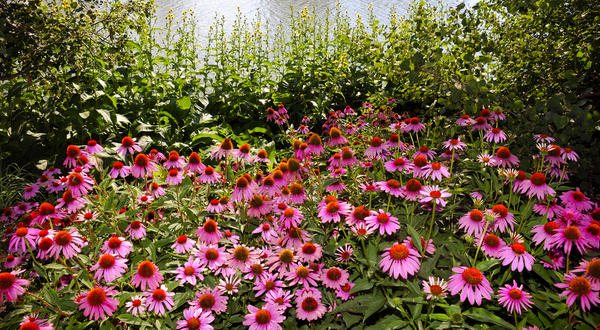

Echinacea fell in love with gardeners not only for its decorative appearance, but also for its unpretentious care. The plant can bloom even with minimal care, is rarely infested with diseases and pests. When growing this crop, it is necessary to observe the irrigation regime, monitor the quality of the soil and periodically apply top dressing.
Watering
Echinacea is moisture-loving, but does not tolerate excessive soil moisture. During the growing season, watering is recommended daily or every two days. It is advisable to carry out the procedure in the evening after sunset. The water should not be lower than the ambient temperature, be sure to settle, rain or melt. Watering should be abundant, but at the same time, you need to monitor the soil moisture.
Top dressing
In the first year of Echinacea's life, feeding is not carried out, since all the necessary minerals are introduced during planting.Starting from the second year, feeding is carried out twice a season - in spring, and then after flowering. It is best to use complex mineral compositions for flowering plants or organics, for example, an aqueous solution of mullein (1:10) or bird droppings (1: 5).
Top dressing must be carried out using the root method. If echinacea begins to fade, turn yellow or grow slowly, it is recommended to add wood ash under the bush, which is a source of potassium. It is not recommended to use nitrogen compounds during this period, as this will reduce the volume of flowering.
Loosening, mulching
Echinacea loves well-aerated soils, where longer and better flowering is noted. As a dry crust forms on the top layer of the soil, it must be loosened to a depth of 5-7 cm. A large number of weeds should not be allowed to develop, which take water and nutrients from the soil. At the same time, mulching is recommended. Hay, humus or sawdust are used as mulch.
Pinching, pinching, pruning
During the cultivation of echinacea, only sanitary pruning is carried out. If you do not plan to save the seeds for propagation, then after flowering, you should cut off the buds along with 1/3 of the peduncle. Before winter, it is recommended to prune the bush as much as possible, leaving only young shoots with pronounced points of growth. During the summer, you need to pinch all leaves and shoots that have signs of disease, severe damage and deformation.
Transfer
The plant can comfortably grow in one place for more than 6 years without the need for transplanting. You can determine the need for the procedure by the state of the bush. In old echinacea, the rate of growth and development decreases, the duration, quality of flowering is lost. The transplant is carried out in spring or autumn, the process can be combined with the reproduction of the bush.
To do this, the flower is carefully dug out of the ground, and then transferred to a new place, if necessary, dividing the rhizome into two equal parts. It should be understood that a split plant has reduced immunity, so less intense and prolonged flowering may occur.
Features and types
Echinacea is a perennial from North America that belongs to the Asteraceae or Asteraceae family. It is a tall plant with a straight stem and a rough surface, which grows up to 1.5 m in height, with green basal and stem leaves. Wide basal roots form a lush rosette above the ground surface, stems are located slightly higher, one after another, in the shape of a lancet. The root system is strong, branched, so that Echinacea can grow in one place for about 10 years.


Echinacea, "born" on the North American continent, is often referred to as "American chamomile"
The flowers of the plant resemble a large chamomile - the center is convex, spherical or conical in shape with hard bristles. Thanks to this feature, the culture got its name - in translation from Greek, echinacea means "hedgehog". After the petals, which can have different shades (most often pink, purple or white, but there are other colors), fall off, the flower resembles a hedgehog.


Echinacea is widely used for decorative purposes.
There are five main types of echinacea - by crossing them, breeders obtain varietal varieties with different petals (double, semi-double, omitted, etc.) and a varied palette of shades.
Table 1. The main varieties of echinacea.
| Name | Description |
| Purple | The most common species, widely used in medicine and horticulture. Feature - large inflorescences with pinkish-purple petals and an orange center. Can live in one place for more than 10 years |
| Narrow-leaved | A variety of plants in the form of small bushes 60-70 cm high with lanceolate leaves and small pink flowers-baskets. It is considered the most unpretentious and hardy, life expectancy is 5-6 years |
| Strange | Stems are straight, do not branch, the plant blooms in early July with yellow inflorescences. It is rarely used in horticulture - it is usually found naturally in the vastness of Canada and the USA |
| Pale | Branched stems grow up to 1.2-1.5 m, flowers are small, 5-6 cm in diameter, unlike other varieties of a flower, it is considered a juvenile. Echinacea pallidus, like the special one, is rarely used for decorative purposes. |
| Tenessian | The bushes are low, compact, and in appearance the plant resembles purple echinacea, but its inflorescences are smaller - about 2.5 cm in diameter |
Advice! There are about 40 varietal varieties of echinacea, but in horticulture, medium-sized (70-80 cm high) and dwarf (35-40 cm) varieties are most often used. They are widely used in any decorative composition. If the plant is to be grown for therapeutic purposes, purple echinacea is the best choice.
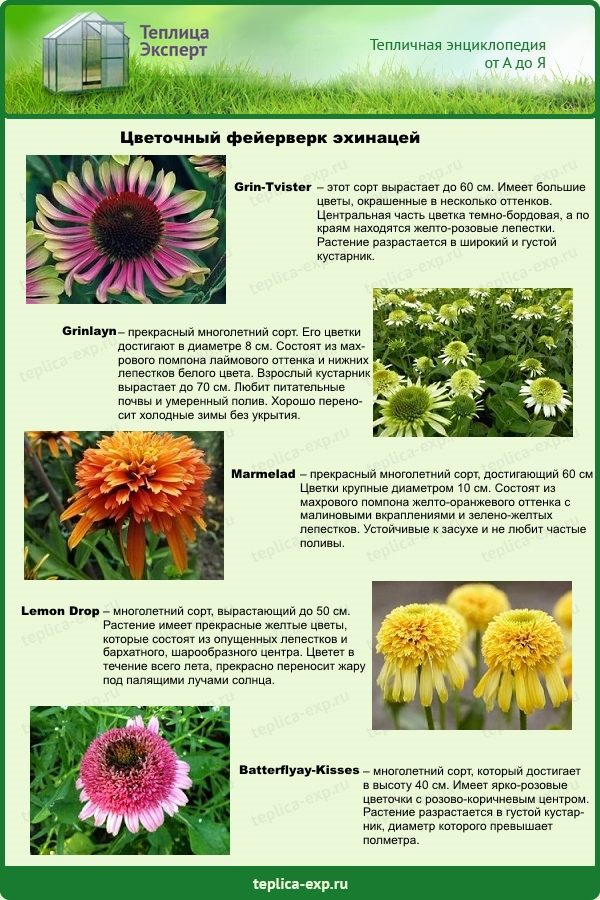

Flower fireworks echinacea
Echinacea seed prices
echinacea seeds
Echinacea after flowering


In winter, shelter is required only in regions where there are long and cold winters with a lot of precipitation (Siberia, the Urals, Karelia and the Murmansk region). In the southern regions of Russia, preparation for wintering is not carried out. In the fall, after the end of flowering, you need to cut the bush, and then mulch the soil with humus or a layer of sawdust up to 7 cm thick. After that, cover with spruce branches with Echinacea, but it is better to use agrofibre or straw.
Echinacea seeds are collected in stages, as they ripen gradually. The maturity of the achene can be determined by the presence of a dark part in the center. After that, it can be carefully removed from the faded bud and dried. They quickly lose their germination, so you need to sow the planting material as soon as possible.
How to use echinacea for treatment
For the preparation of medicines, you can use any part of the plant, but the largest concentration of nutrients is found in the root. Products made from echinacea fight pathogenic microorganisms, increase immunity, heal wounds and calm the nervous system. For infectious diseases, they can be used as a natural antibiotic - they do not contain chemicals and stimulate the production of interferon directly in the body.


Echinacea is used to prepare medicines to fight infections and inflammations
Echinacea - not only a flower that will decorate your garden plot, but also a miraculous medicinal plant that contains many useful substances. If you spend a little time growing and caring for a crop, it will delight the eye for several years and protect against diseases.
Growing features
Echinacea is resistant to disease, infection with infections of a fungal, viral or bacterial nature occurs only against the background of improper care and non-compliance with cultivation techniques. Powdery mildew is the most common. It can be identified by the appearance of spots of a characteristic white color, which eventually turn brown.
The plant stops growing, gradually withers. The most effective remedy for powdery mildew is a colloidal sulfur solution or Bordeaux liquid. The fungicide treatment is carried out in two stages with an interval of 10 days.
When grown in dry or excessively wet soils, there is a risk of viral diseases that lead to deformation of the peduncles and vegetative parts of the plant. If signs of pathology are detected, the plant must be removed from the site, and then the soil must be qualitatively treated with a solution of potassium permanganate. There is no effective treatment for echinacea viruses.
Pests
The most dangerous for echinacea are bedbugs, spider mites and slugs. In case of severe damage, most of the pests can be removed mechanically, as well as by washing the plant with soapy water. Insecticides are used only for severe infection.Complex formulations are recommended as effective drugs, for example, Fitoverm, Actellik or Karbofos.
Diseases and pests
Powdery mildew on Echinacea is the result of excess nitrogen content in top dressing, abundant and prolonged precipitation, as well as sudden temperature changes. Control measures - treatment of plants with Bordeaux liquid or colloidal sulfur.
Numerous spots on the leaves (cercospora or septoria) can completely destroy the culture, as they weaken its immunity. At an early stage, all affected leaves are removed, and in case of severe damage, fungicide treatment will be required.
There is no way to save flowers from viral diseases. Signs of the virus are yellowed and drying leaves, deformed peduncles. To protect healthy crops, it is recommended to urgently destroy diseased specimens (in a remote area), and shed a plot of land with a strong manganese solution.
To combat harmful insects, special chemicals are used - "Karbofos", "Actellik". Most often, Echinacea attracts drooling pennits and bedbugs. When slugs appear, you will have to collect them by hand, and as a preventive measure, you must use folk advice. For example, scatter a large amount of walnut shells around the flower garden. It will be a serious obstacle to the movement of gastropods.
With strict adherence to all the rules for growing and caring for diseases and pests, there will be no.
The healing properties of echinacea
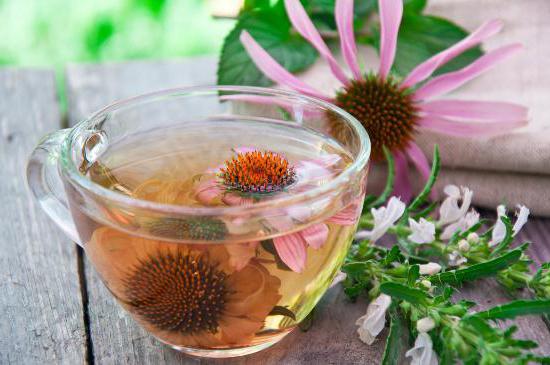

The healing properties of echinacea have been known to people for a long time. Today, echinacea is grown commercially to create medicines. Echinacea purpurea is especially popular in Germany, where it is used to produce remedies for the treatment of angina, sepsis and other inflammatory diseases.
The rhizome, leaves and flowers of echinacea contain a large amount of polysaccharides, tannins, organic acids and essential oils, as well as trace elements (zinc, selenium, silver and cobalt). They have antiviral, antifungal, antimicrobial and wound-healing properties, and also have a beneficial effect on the nervous system, strengthens the immune system. Echinacea is used in folk and traditional pharmacology to create decoctions, juices and tinctures.
Echinacea is a popular ornamental plant known for its unpretentiousness and medicinal properties. It is widely used in landscape design in multi-species and single plantings. The plant does not require complex care, it is recommended for beginners.
Echinacea types
Among florists, the following types are most common:


| View | Description | Flowers |
| Purple | Height 10-20 cm. The shape of the center is a cone. | Large. Contrasting shades. |
| Strange | Decorative. Winter hardy. | Yellow. |
Echinacea purpurea varieties
Most popular in the middle lane:
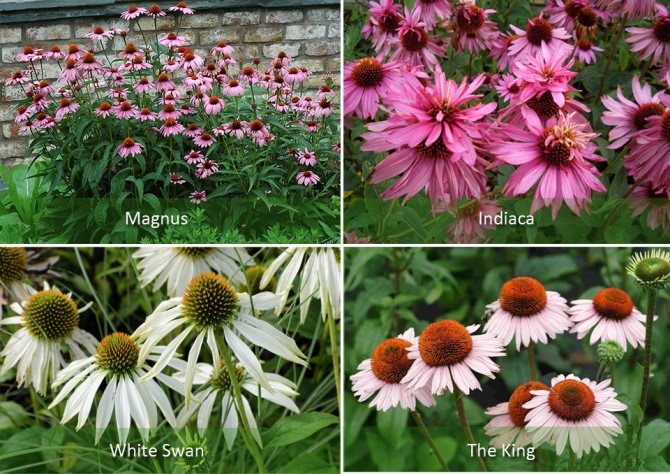

| Variety | Description | Flowers |
| White swan | Convexity of the center. Large. Requires a garter. | Snow white. |
| Cranberry Cupcake | Height 40-60 cm. Petiolate leaves. Drought-resistant. | Inflorescences are baskets. Dark pink. |
| The king | Growth - 100-150 cm. Light-loving. Rhizome plant. | Light pink. Purplish red. The center of the flower is convex. |
| Indiaca | Tall. The core is cones by hedgehogs. | Various shades. |
| Magnus | Tall. Grows up to 1 m. | Raspberry. Bright red. Size - 12 cm |
| Colorbust orange | Height up to 2 m. | Terry. Orange |
| Butterflies Rainbow Marcella | Large. | Dual-tone. Pink smoothly turning into peach. |
| Supreme Cantaloupe | The leaves are large, rich green. | Terry, mango shade. |
| Grinline | Massive, thick shoots. | Light green, dense middle with small lime petals. |
| Cone Fections Hot papaya | The original variety. | A red hat, framed by long hanging scarlet tongues. |
| Aloha | Modest, reminiscent of a chamomile. | Simple, sunny in color with an orange center. |
Fertilizing and feeding - nutrition for bright inflorescences
Echinacea is content with little, but feeding is required for the maximum number of peduncles. The first is carried out in the spring, as soon as the plant starts to grow. At this time, the soil around the hemp, which has turned green with the first fresh leaves, is mulched with organic fertilizer: grass-fed peat, compost, rotted manure.
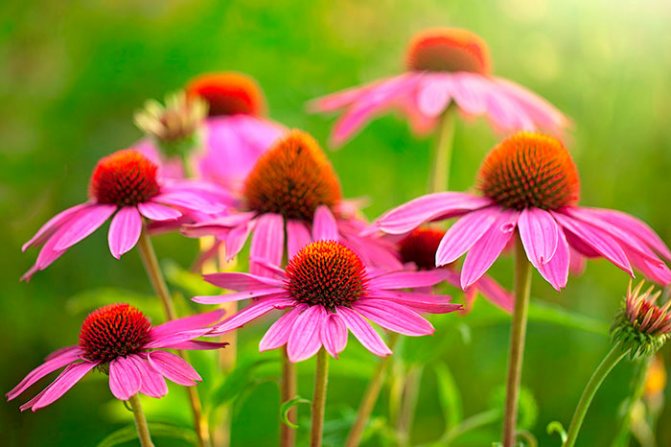

Echinacea can be fed 2 times per season
The second time the echinacea is fed is when it begins to pour out the buds. This is the time of complex mineral fertilization, which will surely contain all the trace elements necessary for bright flowering.
Conditions of detention at home
For good growth, pots with seedlings are placed on a sunny windowsill located in a south or southeast direction in relation to parts of the world. In a warm period, plants should be taken out onto a balcony or veranda. When the end of August comes, the indoor echinacea flower should be brought into the apartment and treated with a strong infusion of garlic.
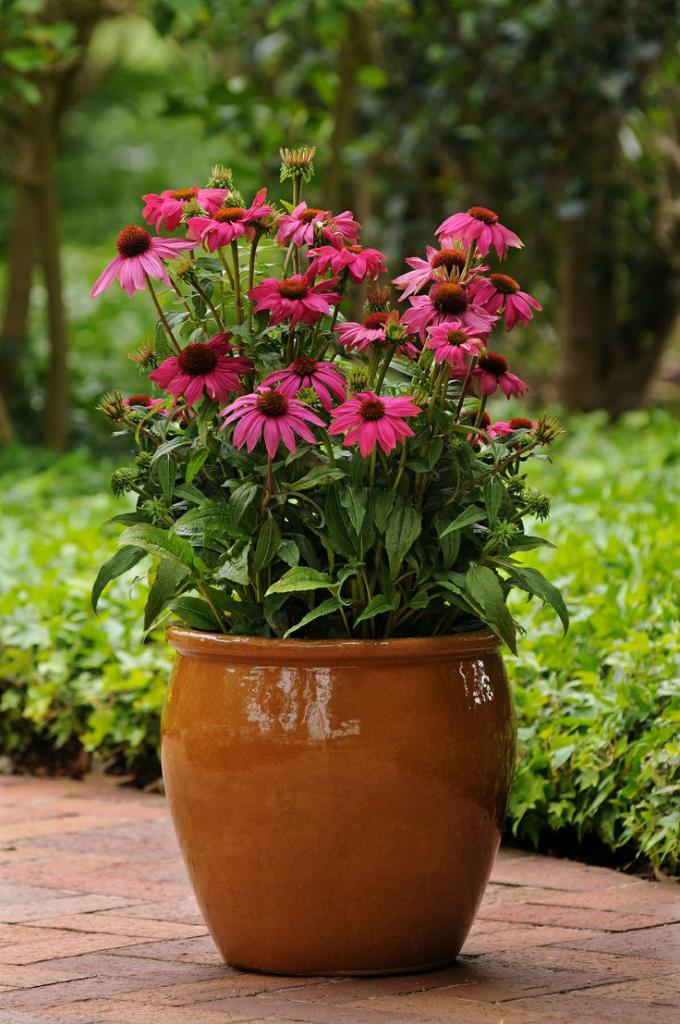

This is a protective measure against pathogenic microbes and small pests that could affect the plant outdoors. In winter, "American chamomile" should grow in a bright, cool room with an air temperature of 12-14 ° C. At this time, watering is reduced, feeding is completely excluded.
Healing tinctures
You can cook them yourself at home. All parts of Echinacea have medicinal properties.
- Tincture of alcohol for internal use. With its help, the body is strengthened. She prepares easily. It is necessary to pour the root of the plant with alcohol, using a ratio of 1:10, and put it in a warm place for one month, let it infuse. Take 20-30 drops before meals, three times a day.
- The body is strengthened by oil tincture. It is prepared as follows: a root weighing 200 g is poured with vegetable oil in the amount of one liter and infused for 40 days. Take for colds, sore throats, flu. Dose and frequency: one tablespoon after eating three times a day.
- Healing tea. It is not difficult to prepare it. To do this, you need to grind three flower buds and two teaspoons of leaves or the same amount of roots. All this is poured into 500 ml of boiling water, infused for 40 minutes and the tea is ready. For prophylactic purposes, one cup is taken a day. With colds or viral diseases, the rate remains the same, but the number of receptions increases up to three times. Tea boosts immunity, cleanses the body and slows down aging. It should be taken for exactly one month. Then take a break for the same time so that the body defends itself.
Benefit
The herb contains almost half of the elements from the periodic table. It contains a lot of tannins and flavonoids, organic acids. The rhizome contains essential and fatty oils, a variety of resins and unique enzymes. Tinctures and decoctions prepared on the basis of echinacea have a powerful antifungal and antiviral, antimicrobial effect. They are able to heal wounds, strengthen the immune system.
They are prescribed for people with physical or mental fatigue. Accelerate the healing of the burn, increase the potency, improve blood clotting - the list of healing properties can be continued for a long time.
By the way, echinacea tinctures and extracts are widely used not only in the post-Soviet space. For example, in Germany they are used in the complex therapy of chronic tonsillitis and tonsillitis. According to the Russian professor S. Tomilin, the medicinal properties of the plant are comparable to that of ginseng.
Discuss it with your healthcare provider before starting therapy. The fact is that echinacea-based drugs have a number of contraindications:
- Individual tolerance - may cause allergies.
- Pregnancy, lactation.
- Diseases such as multiple sclerosis, leukemia, open form of tuberculosis.
Indoor flower
Many people know about the healing properties of echinacea, but it is easier for herbal medicine fans to go to the pharmacy for a medicinal collection.That's in vain, this plant can be grown on a windowsill. The home flower Echinacea is called "prickly like a hedgehog." Indeed, the large center of pineal inflorescences is somewhat reminiscent of an animal that has released its thorns. The popular name is "American chamomile".
Gardeners know the flower as a plant that is grown outdoors. But there were enthusiasts and learned how to breed echinacea at home. It turned out to be convenient: both beautiful and profitable. In the wild, plant height reaches one meter or more. In the interior of an apartment, especially a small one, such flowers are too bulky. Therefore, small varieties are grown on the windowsill: lilac-purple, red or orange-purple, pale pink.
The seed sowing technology is the same as for seedlings. It is described above in the article. When the sprouted sprouts get stronger, they are planted in separate flower pots, in which they will grow constantly. Plants do not need special care.
Procurement and storage
Plants of two years of life are used as medicinal raw materials. Aboveground part: leaves, stems, flowers are harvested in summer, when mass flowering occurs. At this time, plants accumulate a large amount of substances that are called biologically active. You need to cut them off in the morning, but after the dew has dried.
For winter harvesting, gardeners carry out the cultivation of a perennial echinacea flower in their dachas. Bouquets of plants are sent for drying under a canopy or in the attic, as long as they are in the shade. Flowers are dried separately from leaves and stems. Freshly harvested plants can be preserved for a long time if they are placed in a glass bottle and filled with alcohol containing 70% of the basic substance.
The roots are best harvested in the fall, at the end of the growing season. If for some reason it was not possible to do this, they are dug up with the onset of spring, until the leaves have time to grow. The roots should be rinsed under running water, remove any diseased or spoiled ones. You can dry it in any conditions: in the shade, in the sun, in the oven. In the dried raw materials, all properties that are used for medicinal purposes are preserved for two years.


Application in garden design
Echinacea in the garden is in demand because it can beautifully decorate the garden. It becomes a great backdrop for other plants or decorates the foreground of a flower garden. Also, the bushes create beautiful borders, frame gazebos, paths, alleys. An interesting solution is to combine echinacea with cereals, asters, and loosestrife. If you plant a plant in containers, it can decorate stairs, patios. Cut buds are used to form beautiful dry bouquets.
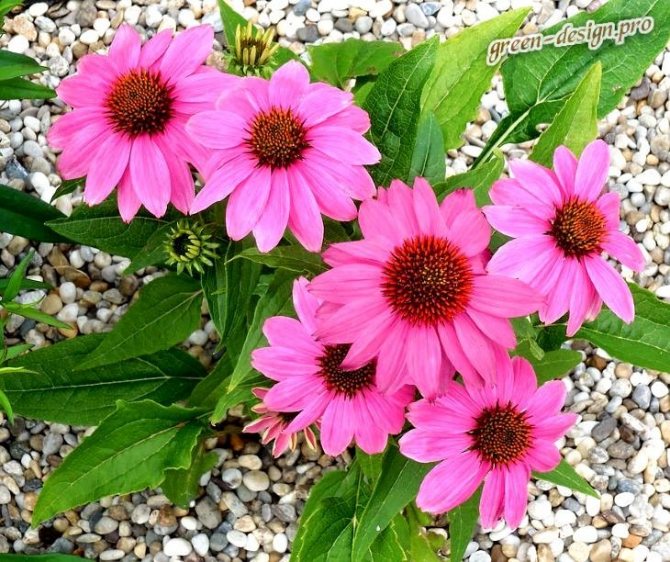

Similar crops
Flowers similar to echinacea are chamomile, gerbera, gatsania, coreopsis, chrysanthemum, pyrethria and others. They are used in the preparation of bouquet compositions and for growing in flower beds, they are unpretentious to care for and frost-resistant. They are distinguished by a long flowering period and beauty. Echinacea and similar flowers are very similar in appearance.
- Chamomile with echinacea is similar in the first, purely visual perception, since the inflorescences of these two plants are in the shape of baskets, and this immediately "catches" the eye. But in fact, the receptacle and the middle flowers differ in structure, the outer ones in color and size. In echinacea, they are large, 10-12 cm in diameter. The petals are long, often hanging down.
- Some varieties of Echinacea bear an outward resemblance to a gerbera. In addition, they can stand in the same way cut in water for two weeks or more. Only you need to put them in partial shade, in a room without drafts, change the water in the vase every two days, spray it during the day, and take it out to a cool room at night.
- Gatsania, which is called "African exotic chamomile", looks like echinacea. Only the structure of the petals with bright stripes at the first flower is denser, the height is less.Upon closer examination, you can, of course, find many differences, but we are talking only about external similarities.


How to take care of your favorite plant in the garden
Caring for the plant is simple, but the preservation of the valuable qualities of echinacea depends on the correct actions. It is important that the flower has enough sunshine, and the ground is well loosened, cleared of weeds and watered. If the plant is planned to be used for the preparation of herbal medicines, then the use of chemicals for fertilization or treatment should be avoided. In this case, only organic compounds are suitable.


Watering frequency
Echinacea is a moisture-loving plant. The soil around it must be constantly moistened. Watering is recommended to be done often, but not too abundant. In hot summer they are watered daily, but only in the evening. When the coolness comes, the soil is monitored and watered as needed. Root watering is useful for plants.
What and how to feed a flower
You need to feed the plant only if the land is not fertile enough. It is best to use organic fertilizer by mixing compost and wood ash. You can also use a complex fertilizer containing nitrogen or potassium phosphate. Spring time should be used for fertilization.
Top dressing is carried out in order to achieve a bright and lush flowering. If you plan to use echinacea as a medicinal plant, then it is better not to feed it.
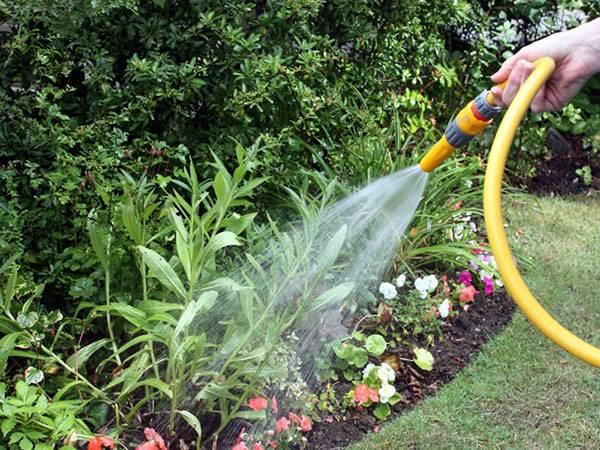

Echinacea bloom
Echinacea blooms only in the second year after planting. The young plant has dense foliage, and the peduncles are still poorly developed. You can admire the abundant flowering from mid-July to early October.
How to collect echinacea seeds
Seeds for future plantings are harvested at the very end of the season - these are the last days of October. The seed pods at this time look like blackened spiny balls. They are cut with short stems and stored in a dark, dry place to dry out over the winter. You can wrap the boxes with a plastic bag and hang them by the stem. Then, as it dries, the seeds will fall onto the polyethylene. They are collected, dried for some time and placed in a refrigerator. This storage method is reliable, it provides seeds with high germination.
See also
Useful properties and use of amaranth in cosmetology and folk medicineRead
Echinacea pruning
In order to preserve the beauty of plants longer, it is necessary to cut off dried inflorescences. New buds will appear in their place. Pre-winter pruning is also done. The foliage and all the stems are cut off at a distance of 5 centimeters from the ground. Roots covered for the winter will survive the winter cold more easily.
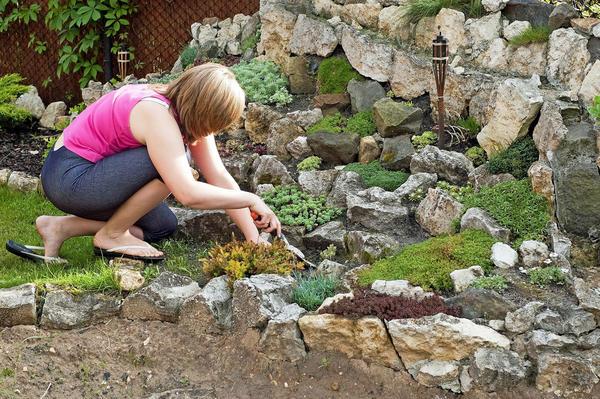

Transfer
It is recommended to replant the plant in late spring or early autumn. This should be done with a clod of earth. After transplanting, it is important that the soil is constantly moistened - this way the plant will more easily be taken in a new place. It is also important to trim the inflorescences before transplanting.
Preparing the plant for the winter period
Echinacea is a winter-hardy plant. But in the climatic conditions of the northern regions and Siberia, it is necessary to properly prepare the plants for winter. Left in severe frosts without shelter, they can freeze out. After pre-winter pruning and mulching with compost, cover the remaining necks of the roots with fallen leaves. The snow that has fallen will reliably protect them from severe frosts. This is especially necessary for young one-year-old plants.
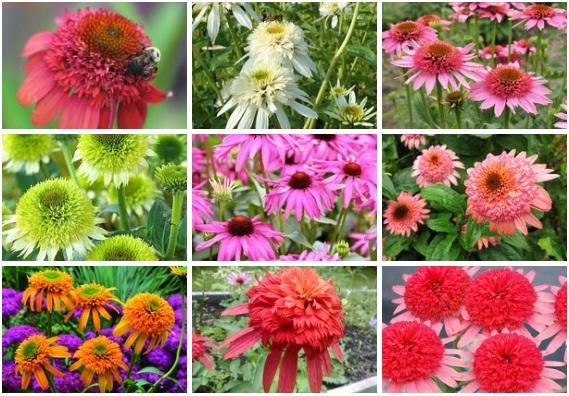

Echinacea: Combination with other plants
In order for echinacea to make an impression on the viewer, it is planted in an amount of at least five copies. As you can see in the photo, in the flower beds she is given the second tier: the harmonious combination of most varieties with tall meadowsweet, fennel, burnet, red-leaved barberries looks stylish and noble. Designers recommend growing echinacea in contrast to astilbe, phlox and cereals.
Healing, melliferous and unusually expressive, Echinacea will be a worthy decoration for any garden.Find a sufficiently lit corner for her and do not forget to water generously, plant next to neighbors with vertical inflorescences - and enjoy her bright thorny bumps framed by drooping petals.
Content
- Echinacea varieties with photos and names
- Echinacea perennial planting and care
- Watering echinacea
- Fertilizers for Echinacea
- Echinacea bloom
- How to collect echinacea seeds
- Echinacea pruning
- Echinacea preparation for winter
- Echinacea seed growing
- Echinacea propagation by dividing the bush
- Echinacea propagation by cuttings
- Echinacea diseases and pests
- Echinacea medicinal properties and contraindications
- Echinacea folk recipes
General information
This plant from the Astrov family has five to nine species and many varieties, which differ in flower size, petal color and other characteristics. But only purple echinacea received detailed study. Therefore, when it comes to this flower, this variety is most often meant.
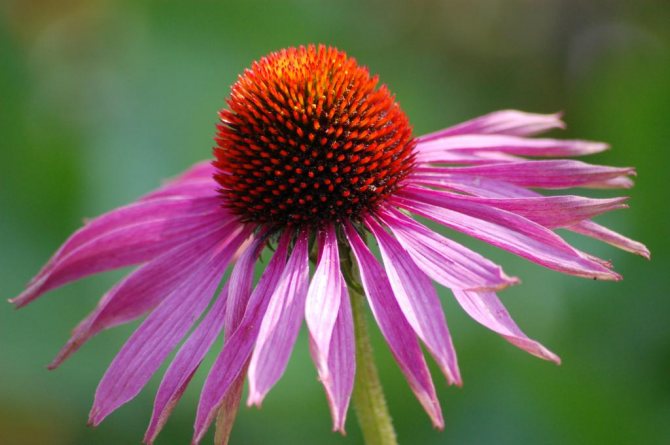

Echinacea flower is native to North America. In the wild, the places of growth are fields, rocky hills, limestone wastelands, damp soils, dry steppes, light sparse forests, but these should always be open spaces. The indigenous inhabitants - Indians, knew about the healing properties of the plant, so a century ago they cultivated it and began to grow it for medicinal purposes. The perennial echinacea flower made its way to Europe after the discovery of the American continent. In our country, the places of growth are the European part.
What is sick?
Echinacea and rudbeckia are plants that have strong immunity to diseases and many pests. Usually, problems arise if the gardener has not properly looked after the flower. Due to high humidity and drought, accompanied by temperature fluctuations, powdery mildew appears on the leaves. Try to "feed" Echinacea with nitrogen fertilizers - and the result will be the same. As soon as you notice a whitish coating, spray the plant with Bordeaux mixture. By the way, colloidal sulfur is fine too.
In an unperturbed state, it is still possible to cure fungal diseases of septoria and cercospora. It is enough just to cut off all the diseased areas. But if the plant is heavily infected, it will have to be destroyed. Or try to save it with a fungicidal preparation, but the chances are slim.
Bedbugs and slugs can also feast on juicy rudbeckia leaves. Insect pests are exterminated with insecticides. For example, Aktellikom, Karbofos. Slugs are collected by hand.
Fertilizers for Echinacea
A plant planted in fertile soil does not need feeding. But the depleted soil needs to be fertilized. Do this in the spring using fertilizers that contain nitrogen: mullein, saltpeter, urea.
Re-feed during flowering. For this, any complex fertilizers containing potassium phosphate are suitable. If you plan to grow echinacea to create medicines, any feeding is contraindicated.
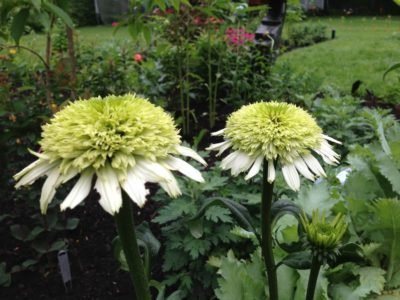

Echinacea propagation by dividing the bush
This is the easiest and fastest way to propagate a plant. You can divide bushes that have reached the age of three or four years. This procedure is carried out in May or April.
To do this, you need to carefully dig out the bush and divide the rhizome. In order for the roots to take root in a new place faster, treat them with a growth stimulant before planting.
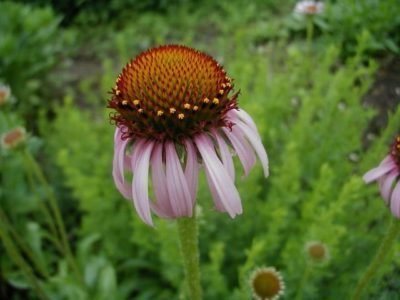

Healing properties
Echinacea flower is a popular medicinal plant with a long history. It has been used since ancient times in folk medicine. So, in America, the roots were considered the best remedy for snake bites, striking with their poison, they were used to treat blood poisoning. Self-prepared tinctures, decoctions, ointments were used for all kinds of ulcers, tumors, infected wounds, colds, and animal bites. Already at the end of the 17th century in the United States, this plant was included in the official pharmacology. In European countries, scientists describe two types of this plant: purple and narrow-leaved echinacea.
For about three decades, the study of the medicinal plant began to be studied in many countries of the world. It turns out that treatment with any traditional methods simultaneously with echinacea becomes much more effective. Currently, root-based extracts and herbaceous parts of the plant, including flowering inflorescences, are used to prepare 240 different preparations. Echinacea flower is found in patented AIDS medications. Preparations containing this plant in their composition have a stimulating effect on human immunity.
In our country, on the basis of the echinacea purpurea flower, an immunostimulating agent "Estifan" has been produced, which has been approved for use since 1995. Today, pharmacies sell medicines from foreign manufacturers with echinacea in their composition: "Golden Root", "Active Day" and many others. You can buy candy, soda sweetened water, tea.
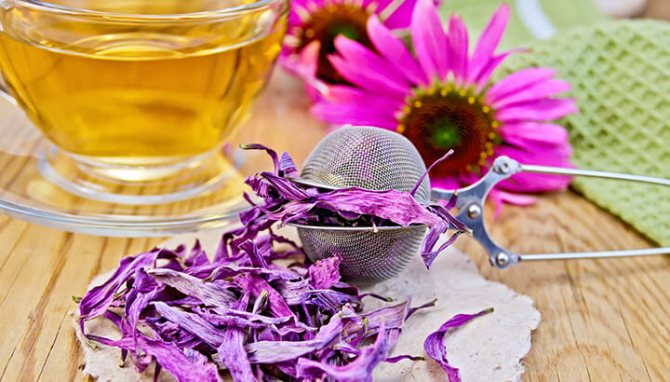

Medical experts recommend the use of echinacea for diseases such as bronchitis and meningitis, otitis media and stomatitis, burns, blood poisoning and inflammation of the gums. The plant is used to treat eczema and psoriasis, purulent ulcers and boils, gangrene, herpes and much more.
Echinacea is useful as an adjuvant in the treatment of diseases of oncology, lymphatic system, thyroid gland. It is used for depletion of the body, depression, fatigue. Helps with rheumatoid arthritis, diabetes. It is used to treat diseases caused by the effects of harmful substances on the human body.
It turned out that the echinacea flower not only has antiviral and antibacterial effects, but also as antibiotics, kills bacteria, viruses and fungi. This plant is like an ambulance for the body, therefore it is used during the period of massive spread of infections.
Echinacea preparation for winter
This is a hardy plant, but it is better to help it survive the frost. After autumn pruning, cover the root collars with compost and cover with a layer of dry leaves.
This procedure is primarily necessary for one-year-old shrubs. Sheltered for the winter, they will easily survive the cold, and in the spring they will grow again and please with their first flowering.


Collecting echinacea seeds
In order to propagate echinacea using seeds, you can collect them yourself and plant them on the site the next year.
To do this, you need to choose a faded flower with a ripe head and cut it off with a sharp knife with a small part of the shoot. Place the head in a paper bag or cloth bag, turn the stem upside down, after which the seeds will remain in the bag. Remove the resulting seed material in a dry, ventilated room, spread evenly on paper, dry for 10 days. After this time, remove the seeds in a glass or plastic container and store in the refrigerator. Echinacea seeds have a shelf life of 24 months.
It is noteworthy that in this way it is possible to propagate echinacea of all varieties, except for terry, which are propagated vegetatively. But this rule has an exception. There were cases when seeds were collected from double varieties and successfully received new plants that fully retained the characteristics of the mother flower.
How to collect echinacea seeds
Seed at the end of the season. To do this, choose dried and blackened heads. They look like spiky balls.
Cut off these pods together with the short stems. Then fold into a bag and store in a dark place until next year. During this time, they will dry out well and will be ready for planting.


Echinacea perennial planting and care
This plant reproduces by self-seeding. The period of seedlings dumping occurs in the fall, and in the spring the first shoots appear. If you decide to plant seeds directly outdoors, do the same. But this method does not guarantee that all the shoots will sprout in the spring. You may come across a weak seed that will simply die.
For many shoots, plant seeds in cups of nutrient-rich soil.This should be done not in the fall, but at the end of February. In the spring, the seedlings will be ready to be transplanted to a permanent place in the garden.
Seed preparation
If the seedlings are immediately planted in the ground, they will germinate in 2-4 weeks, or they may not emerge at all. To ensure that seedlings are obtained, the seed must be prepared.
To do this, wrap the grains in cheesecloth or cotton wool and soak in water. Keep the package moist and roots will appear in a few days.
Planting seeds
When the seedlings hatch, they can be transplanted into the ground. Any store-bought flower soil will work as a breeding ground. It is convenient to use cups or cassettes for planting seedlings. The room temperature should be between + 15 ° C and + 20 ° C.
Fill the cells with soil and make small indentations with a stick. Plant the seeds in these grooves, root down, so that the heads are visible. Then water liberally. After a few days, the sprouts will sprout, shedding the seed coat. Maintain moderate soil moisture.
Transplanting seedlings into open ground
Echinacea loves to grow in slightly acidic or neutral soils. In a soil with high acidity, add woody hall or hydrated lime. Add black soil or humus to sandy soil.
Transplant seedlings in May, when it is warm outside and the soil is warmed up. Choose open areas with good lighting. To plant the plants correctly, dig holes 30 cm apart. Make the depth of the pits according to the size of the rhizome. After replanting, monitor soil moisture and remove weeds regularly.
Santolina is also a member of the Asteraceae family. It is grown when planting and nursing in the open field without much hassle, if you follow the rules of agricultural technology. All the necessary recommendations for growing and care can be found in this article.


Popular varieties of Echinacea Sunset flower
Echinacea Sunset (Echinacea x sunset).
It is a hybrid with large inflorescences. The petals are slightly curved, can be coral, bright pink, orange or yellow. The central part is terracotta shade. This species has a strong pleasant aroma.
Echinacea Sunset varieties:
"Yulia" - variety 40 - 50 cm high. Flowers are rich orange with a brown center;
"Cleopatra" - variety with inflorescences-baskets with a diameter of 8 cm. Petals are yellow, the central part is burgundy;


Evening Glow - variety with a conical dark brown core, ligulate flowers of a bright yellow hue with an orange stripe on the petals;


"Cantaloupe" - ligulate flowers are two-row, yellow-pink, the central part is yellow-brown, fluffy.


"Passion Flute" - ligulate inflorescences are tubular, bright yellow, with a greenish-brown core;
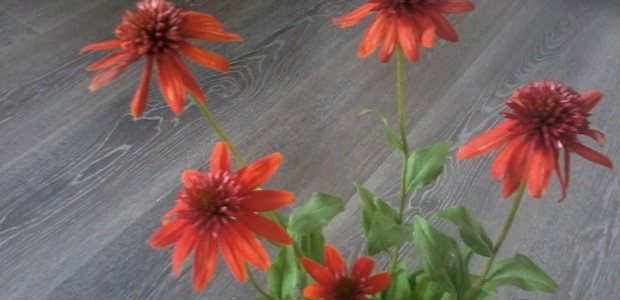

"Double Scoop Cranberry" - a spectacular variety of echinacea with deep red flowers.
Look at the photo, which shows how the varieties of Sunset Echinacea look, what their colors and shades of foliage are:
Requirements for the growing conditions of echinacea in the garden
Location. Having decided to grow a perennial echinacea flower, choosing a site for this culture, you need to take into account that it is photophilous, in the shade and partial shade its decorative effect will be lost. Choosing the right place is also important for the reason that a transplant will not be required in the next 10 years.
The soil. Prefers loose fertile soils with a neutral or slightly acidic reaction. The culture will grow poorly on light sandy soils, as well as heavy, waterlogged and acidic soils. If the soil is in an area with high acidity, you need to add lime when digging.
Watering. The plant is hygrophilous. When creating optimal growing conditions for echinacea, it must be remembered that watering is required during dry periods, but excess moisture in the soil should be avoided, from which the petals will fade and fall off. It is recommended to irrigate the bushes in the evening. After watering, loosening of the soil is carried out, the elimination of weeds.
Top dressing. It is necessary to make 2 - 3 top dressing per season with full mineral fertilizer and organic matter.The first - in early spring, the second - at the end of flowering. To enhance flowering, use top dressing from wood ash and rotted compost. Using humus as a fertilizer, you should finely crumble it near the bush, otherwise it can burn the soil and dry the root of the plant.
Another care. After the end of the growing season, the shoots are removed and the place of growth of this plant is marked. In a cold, snowless winter, echinacea can freeze out, so it is better to slightly mulch it with a dry leaf.
By observing all of the above requirements for breeding echinacea, you can get a beautiful, long-flowering bush.
How the echinacea flower care is carried out is shown in a selection of photos that helps to understand this process and understand that it is quite simple:

